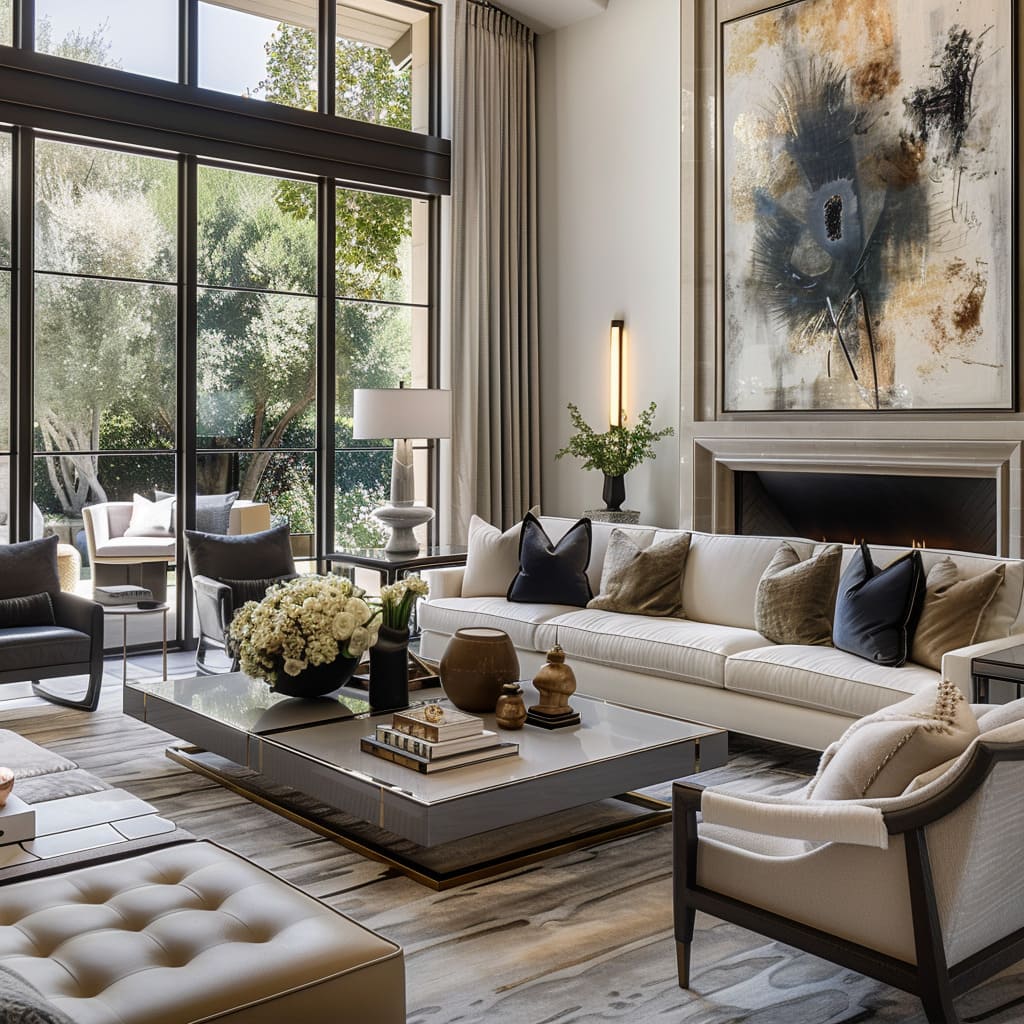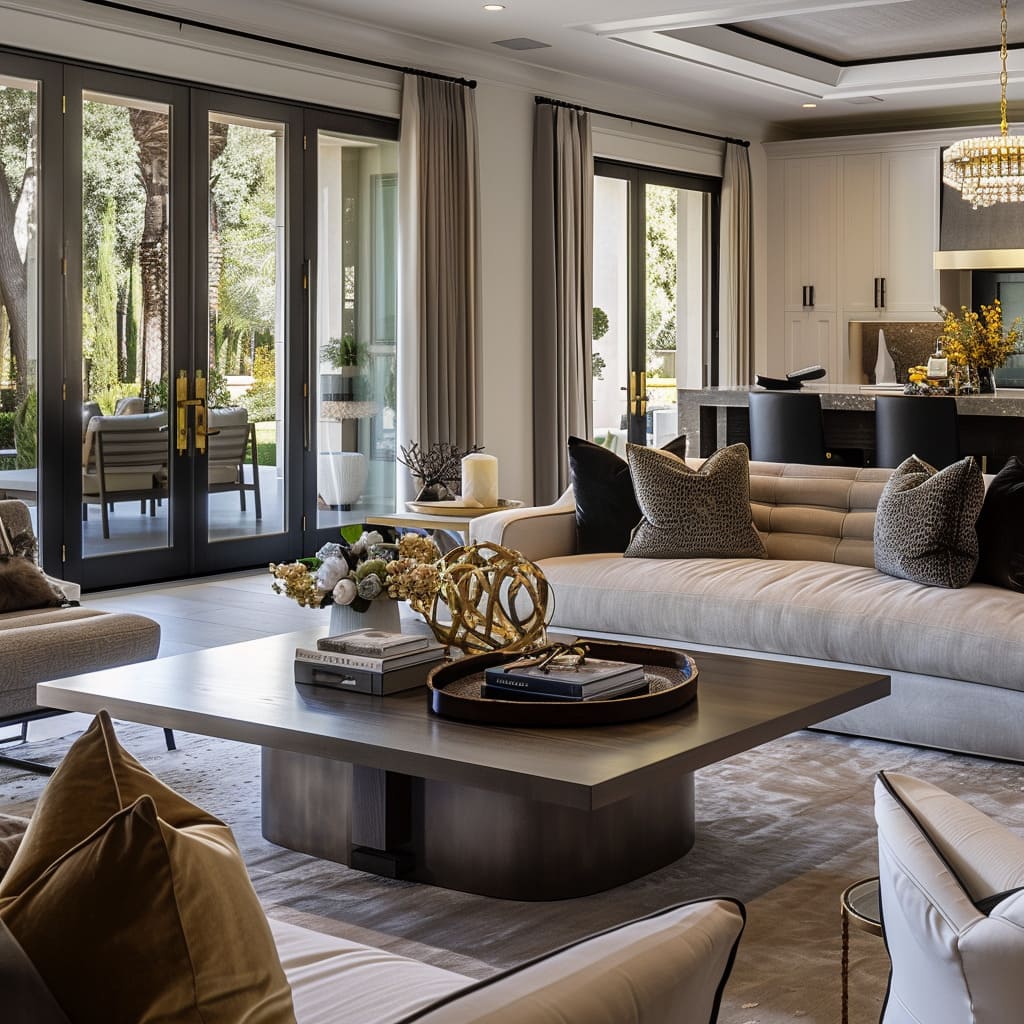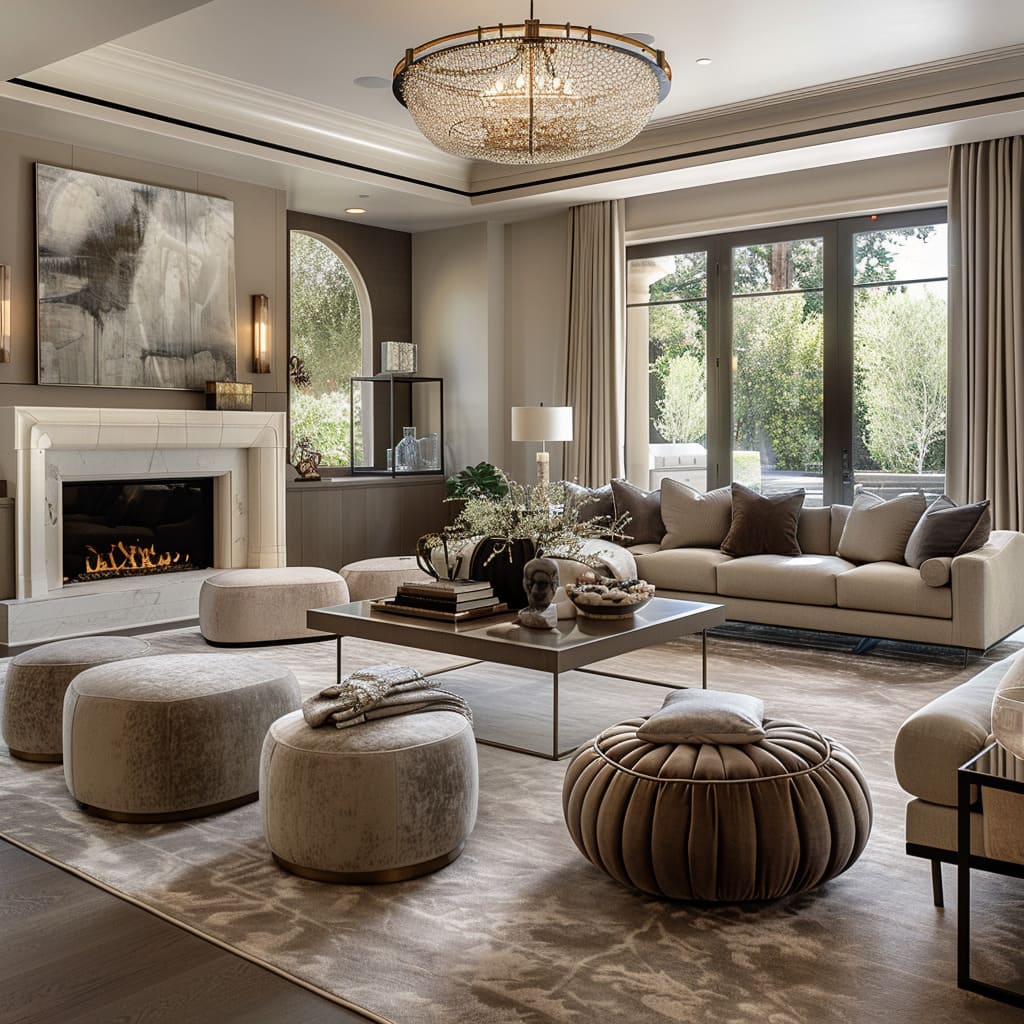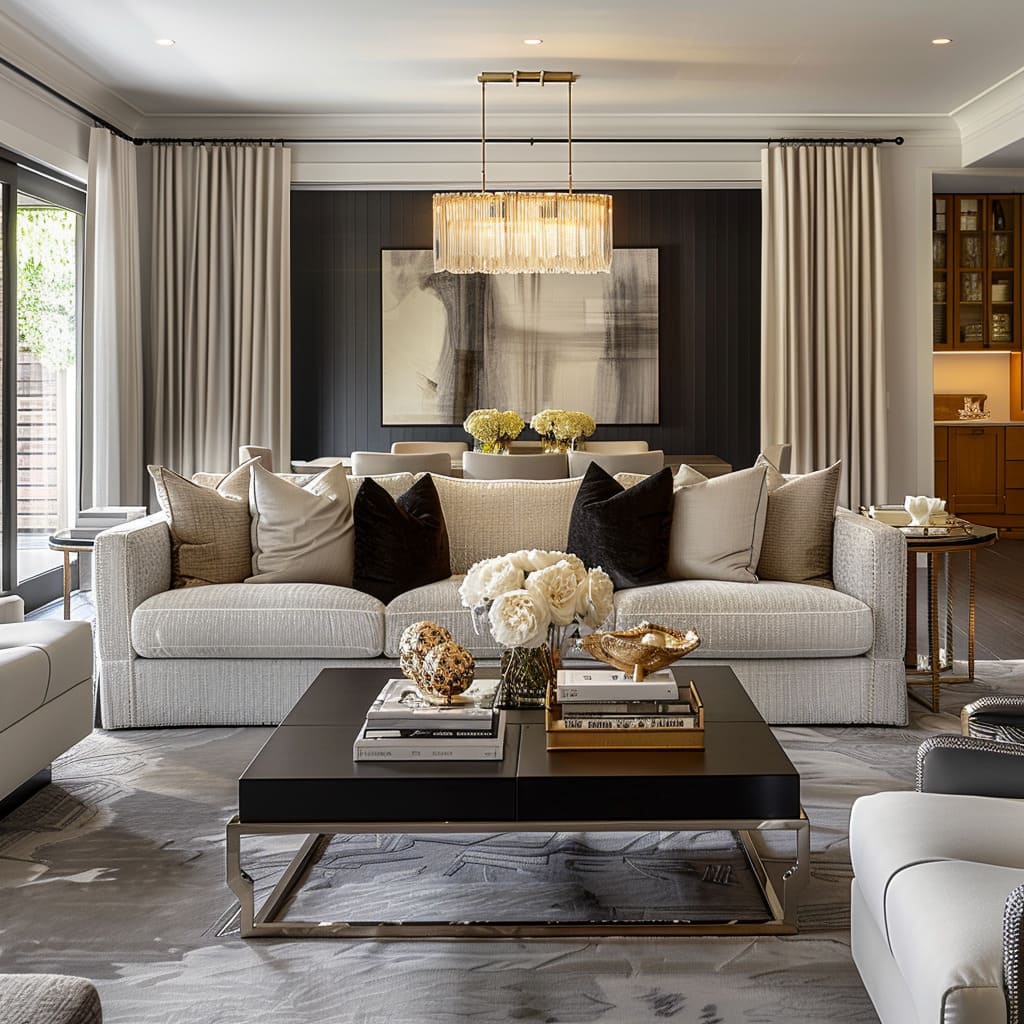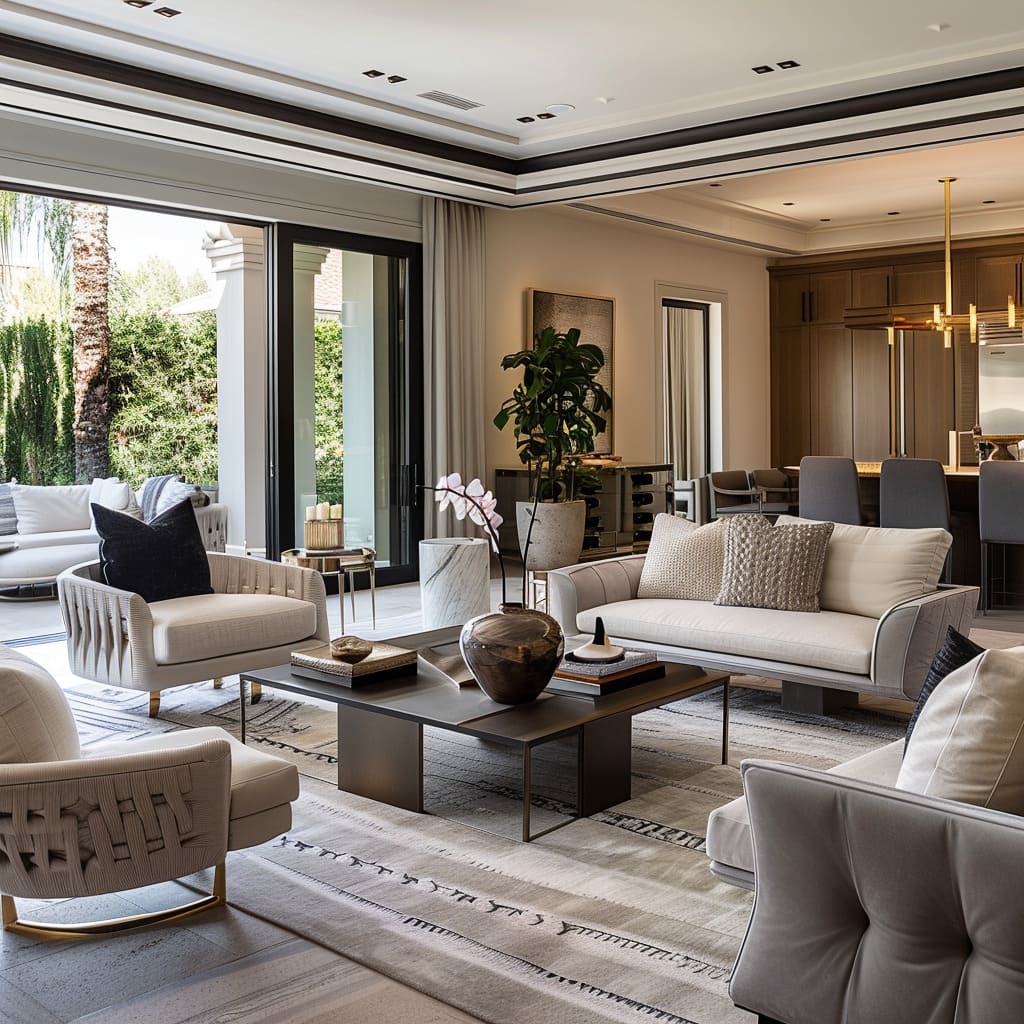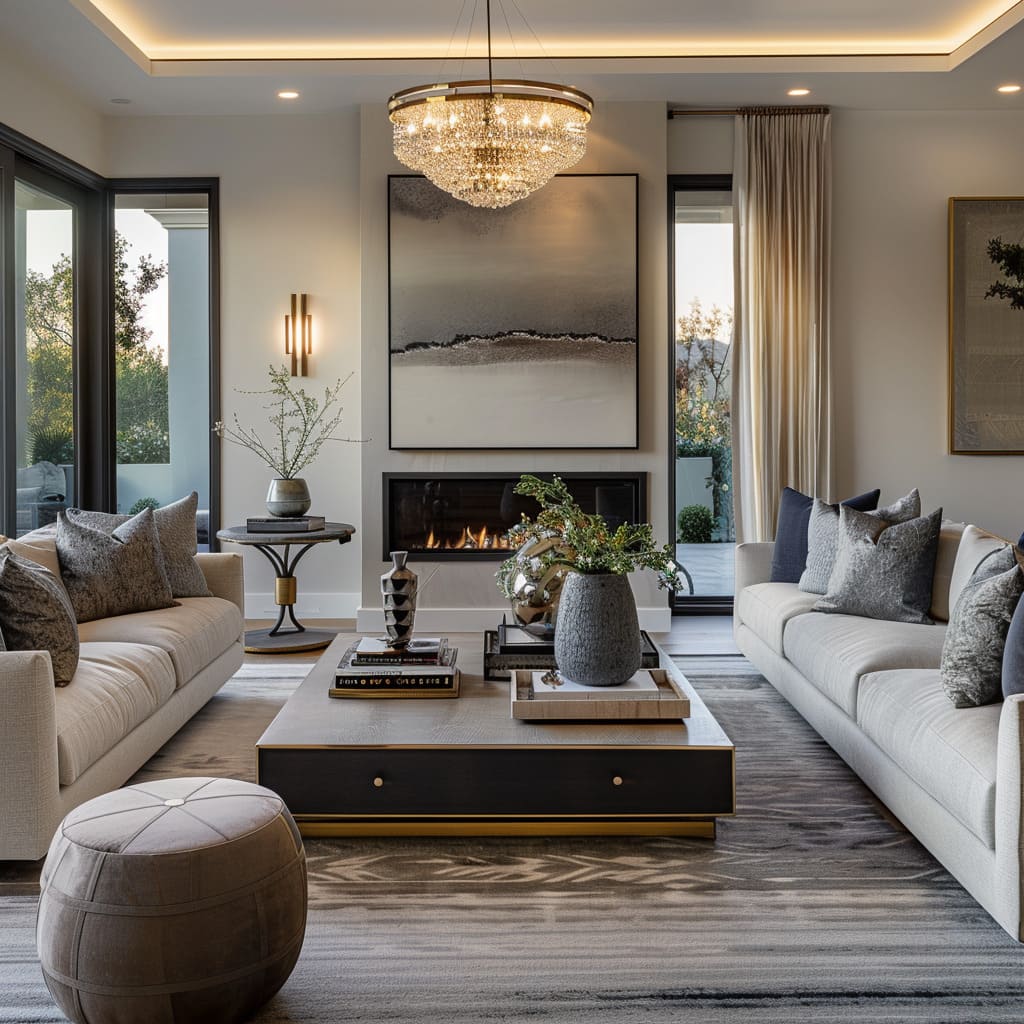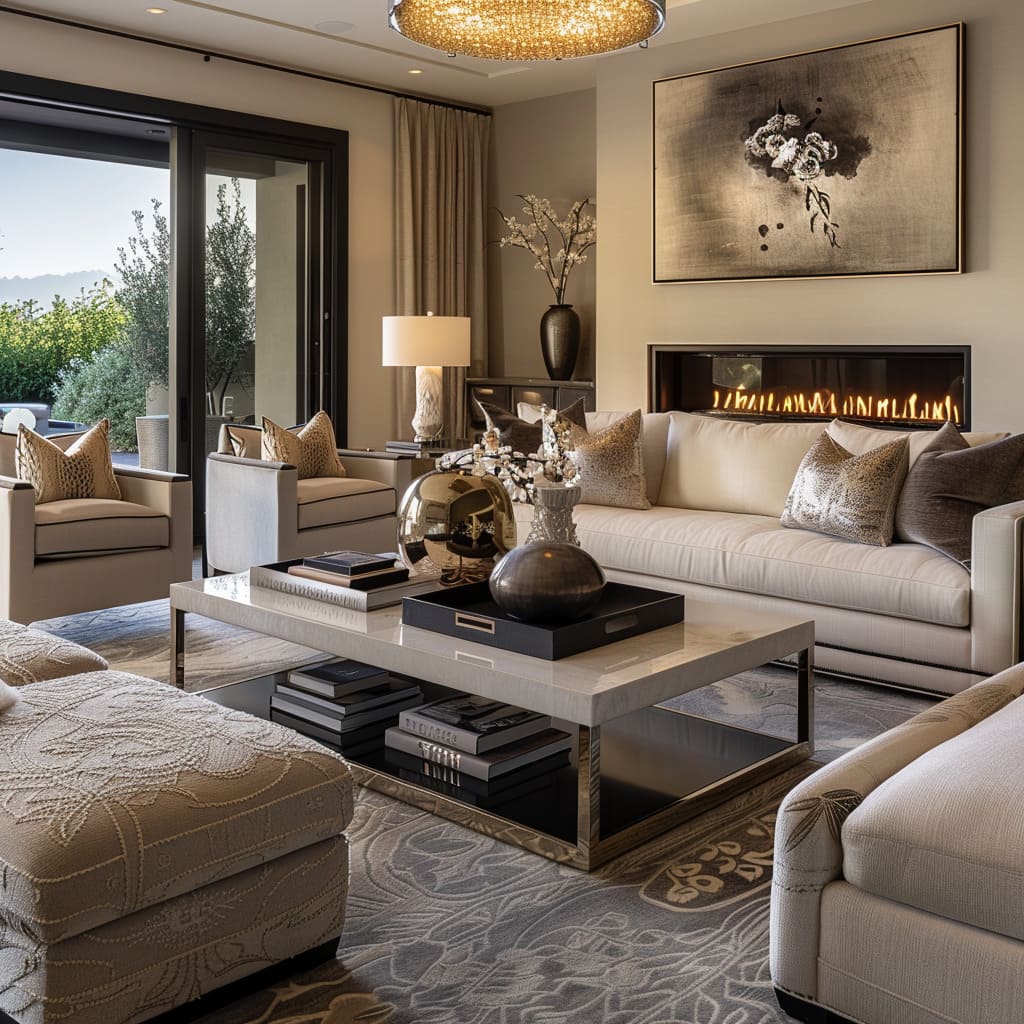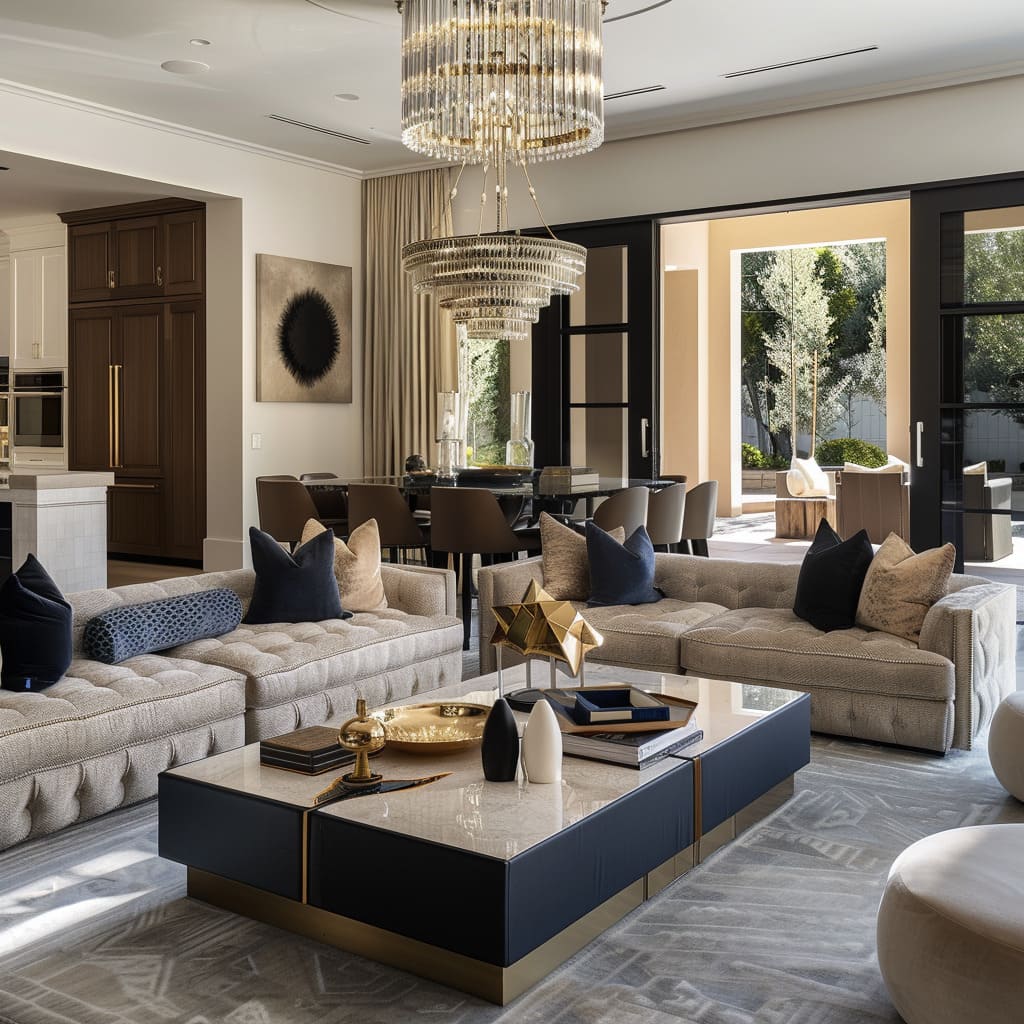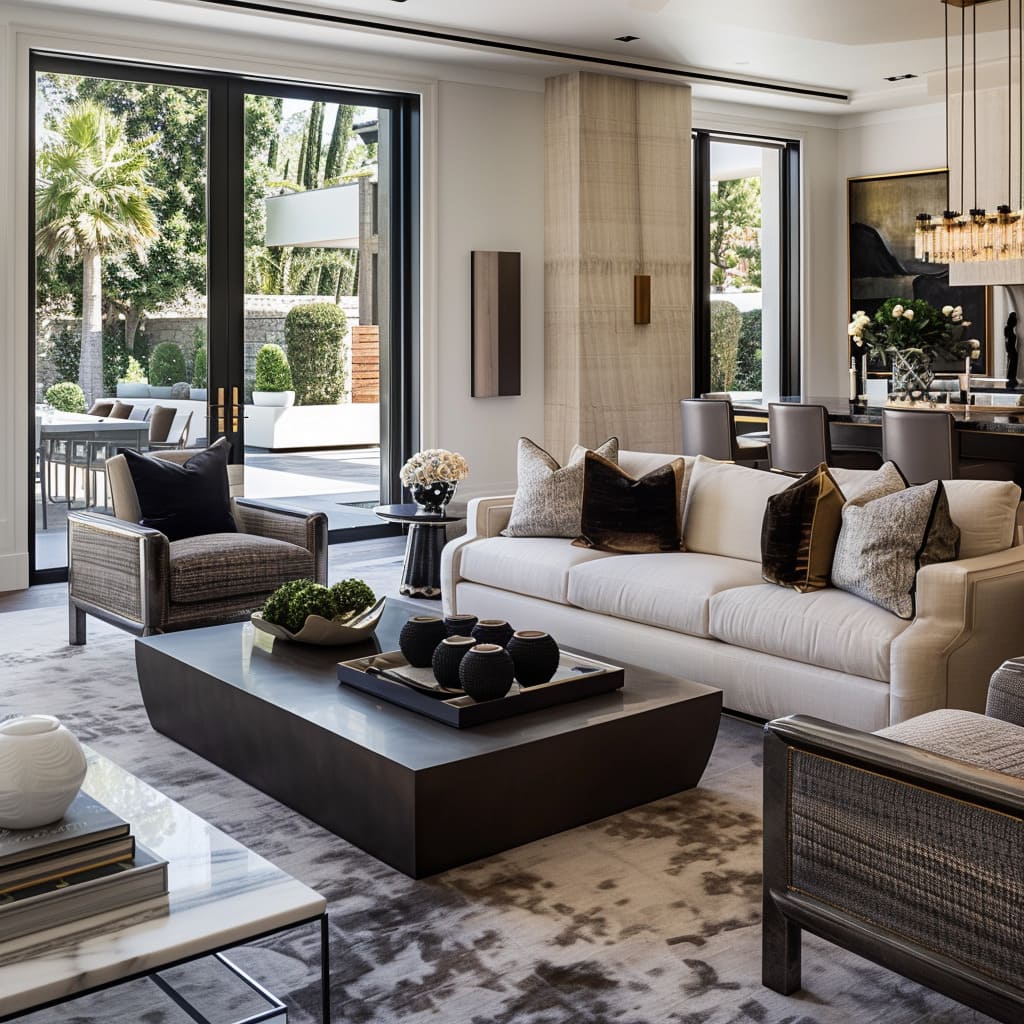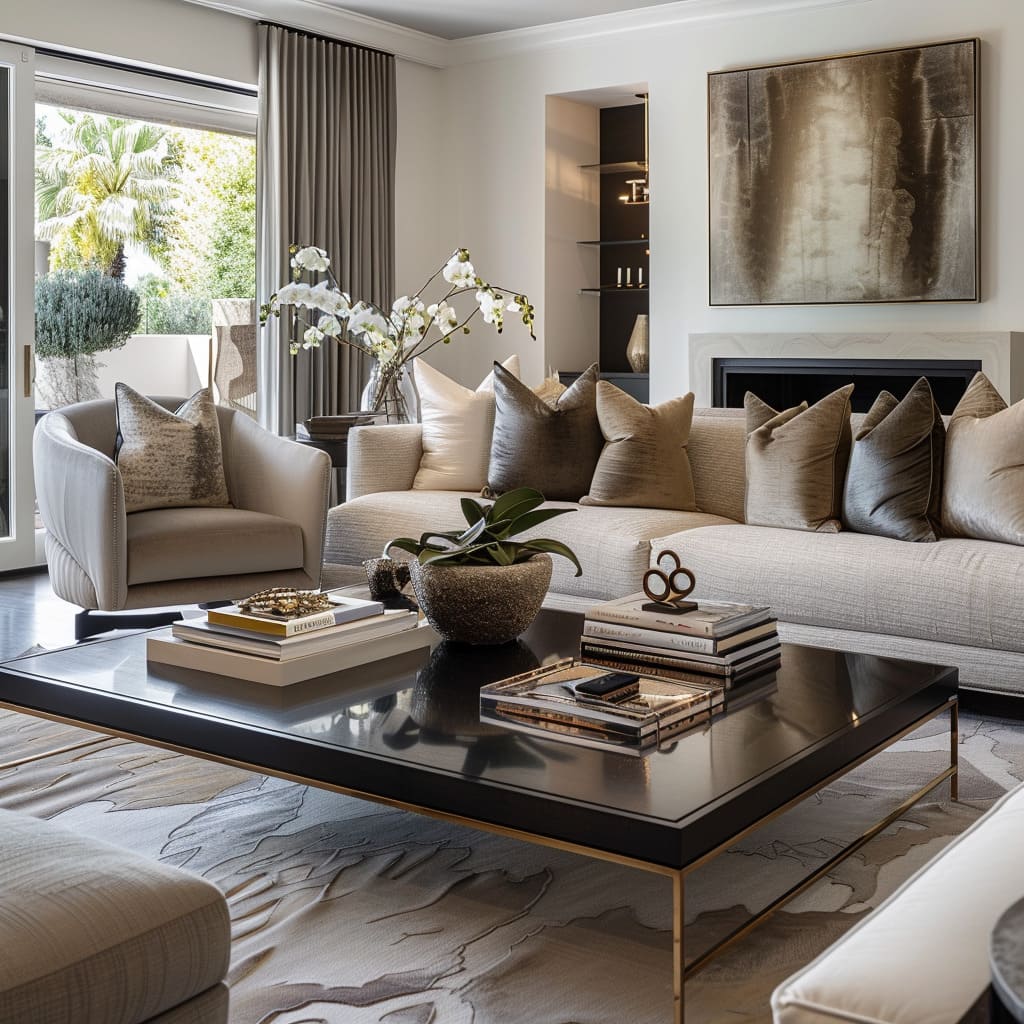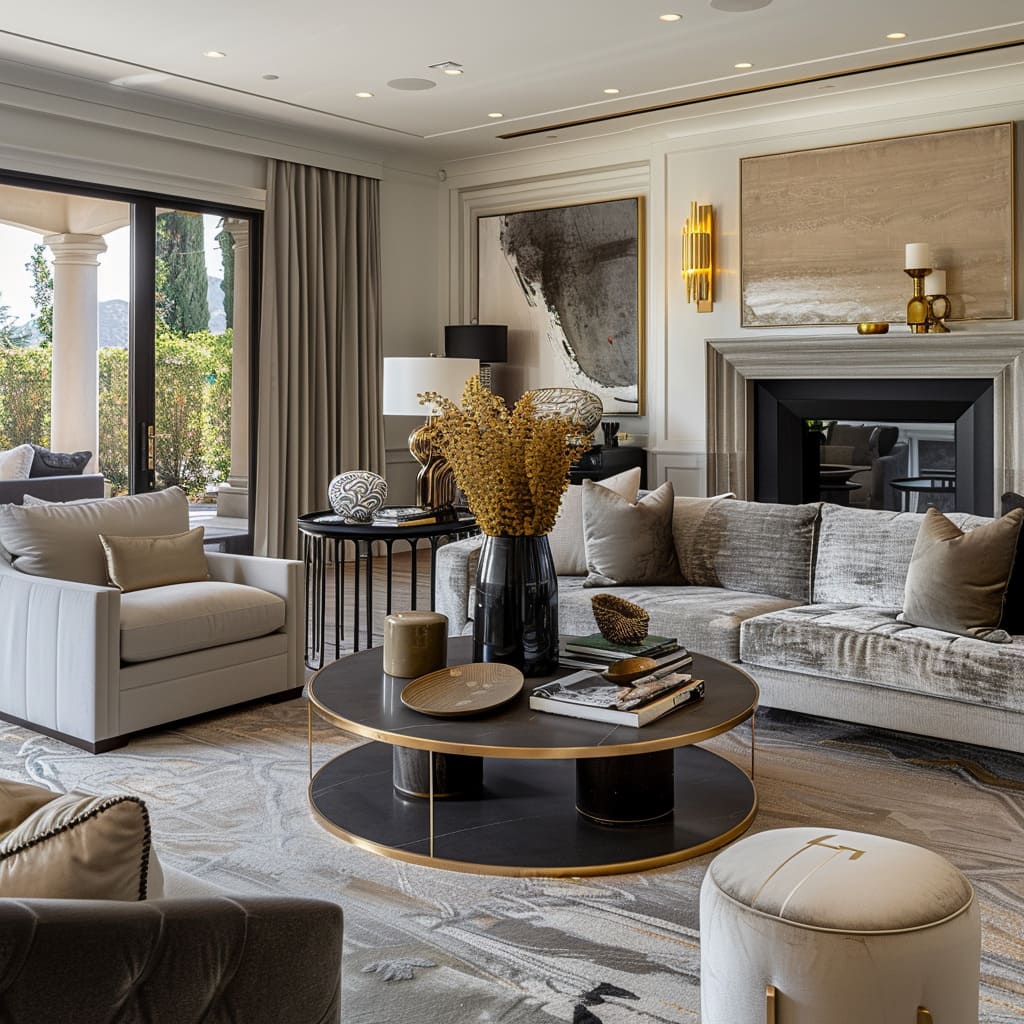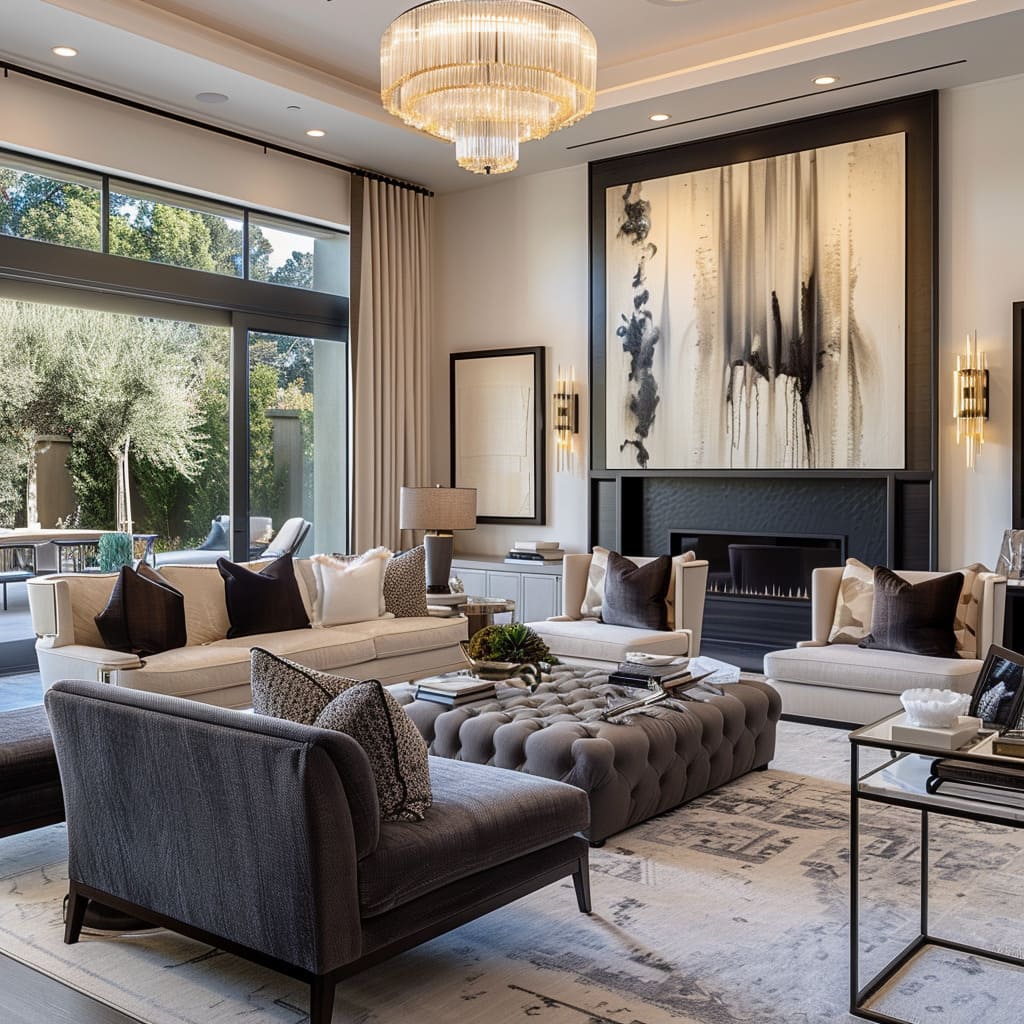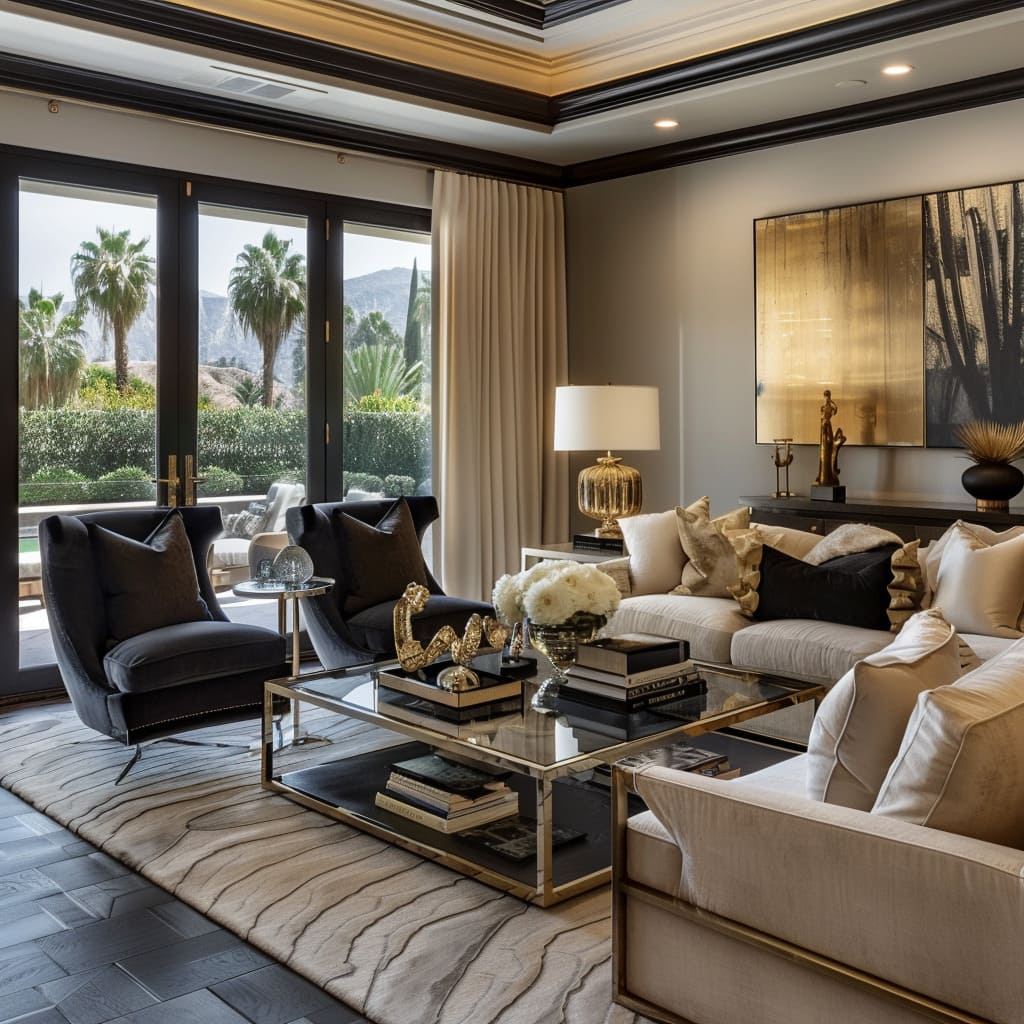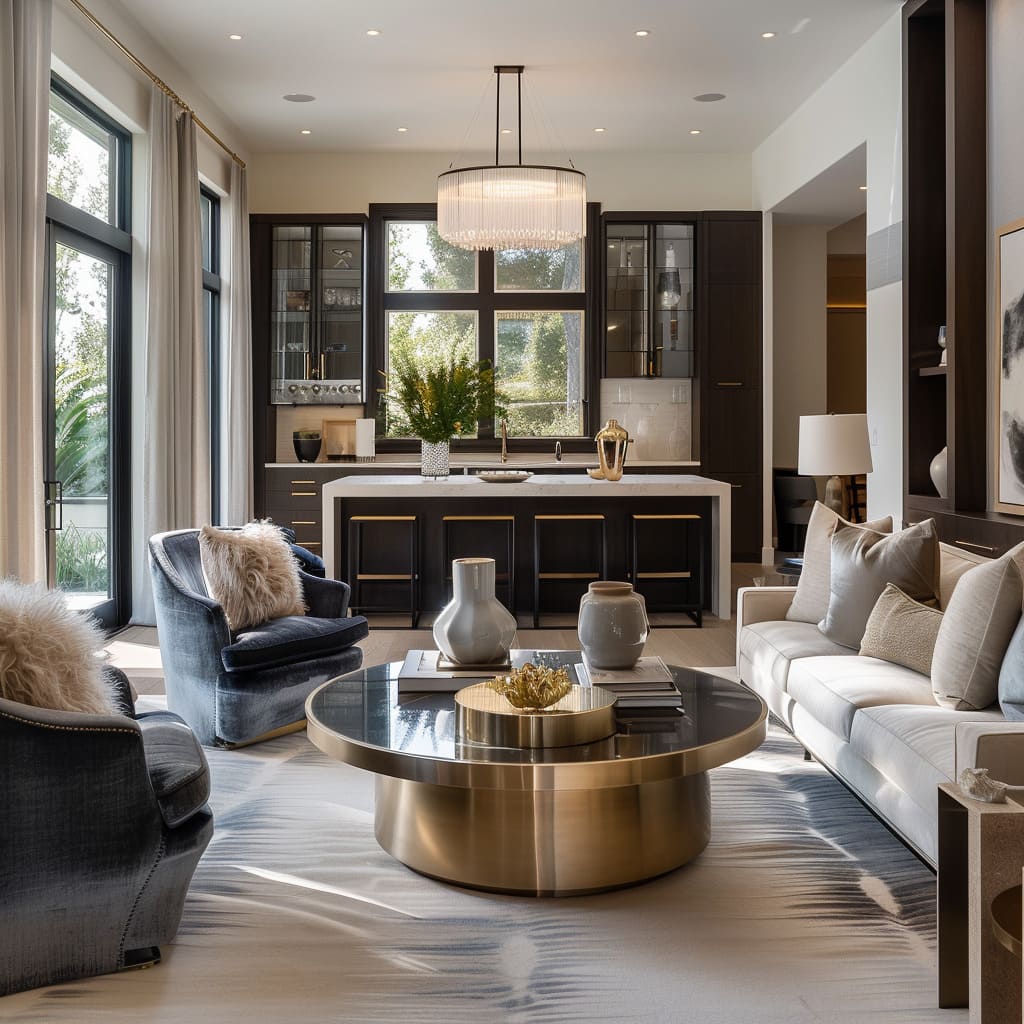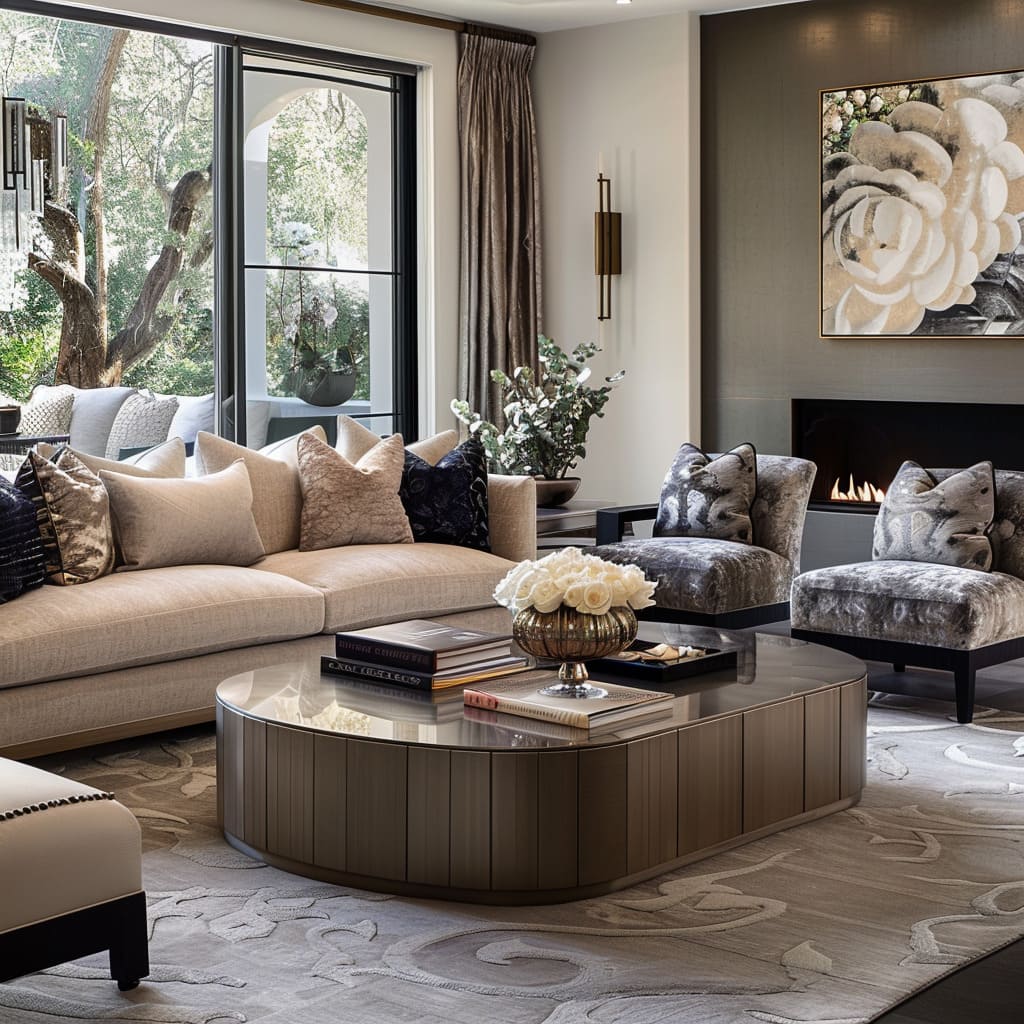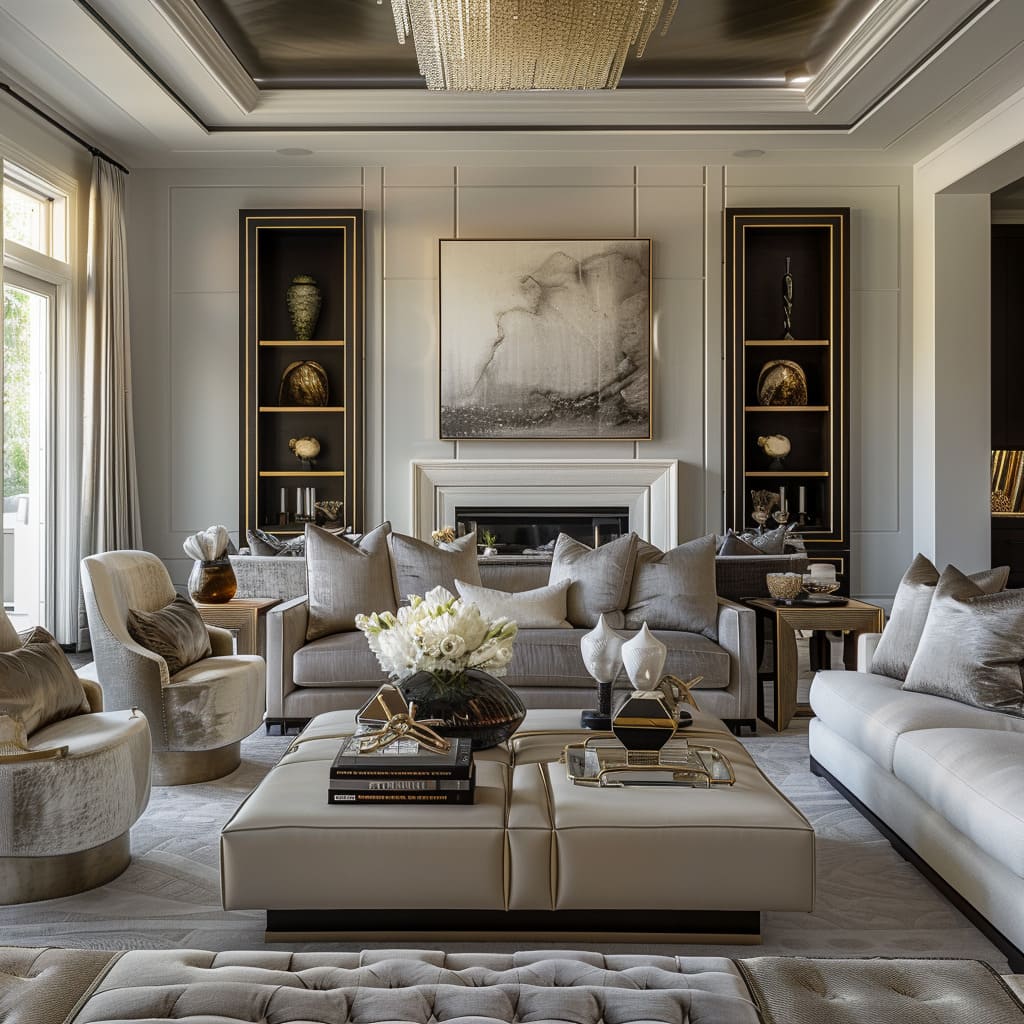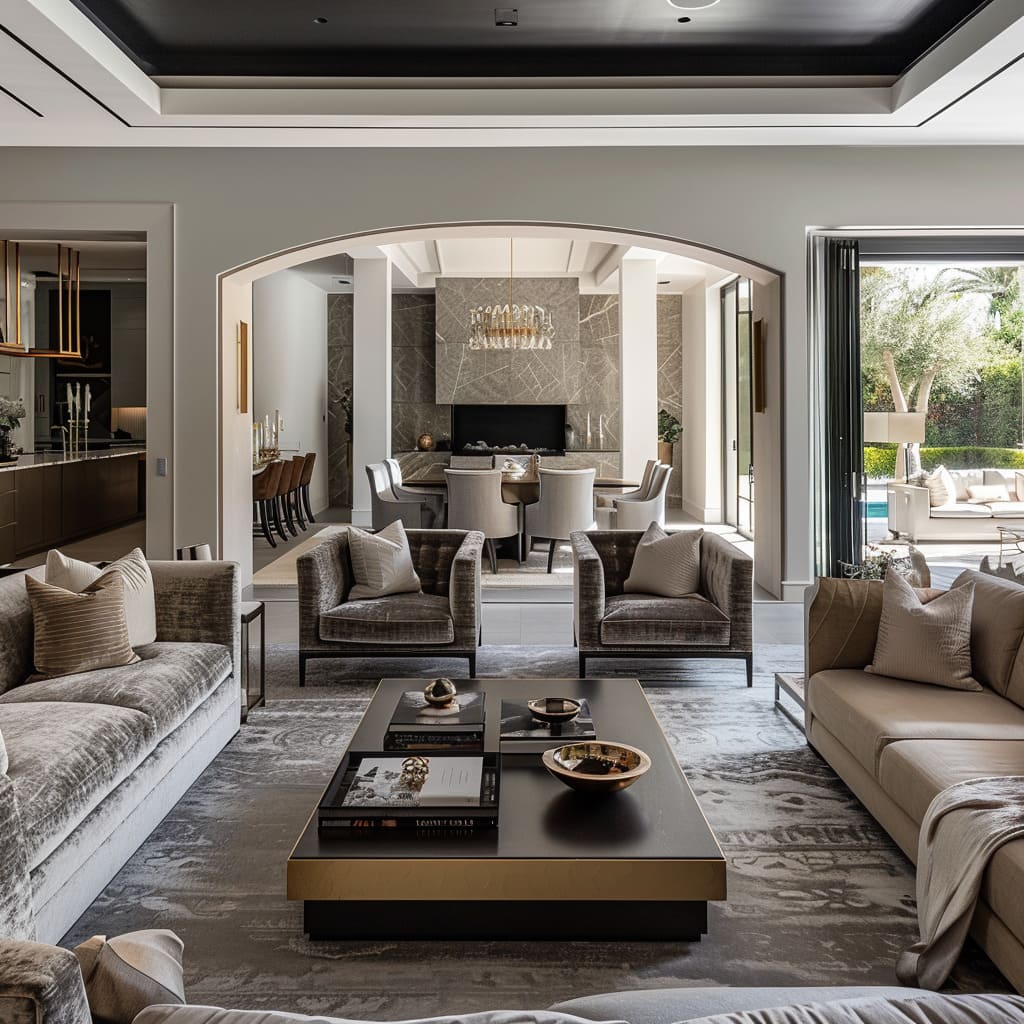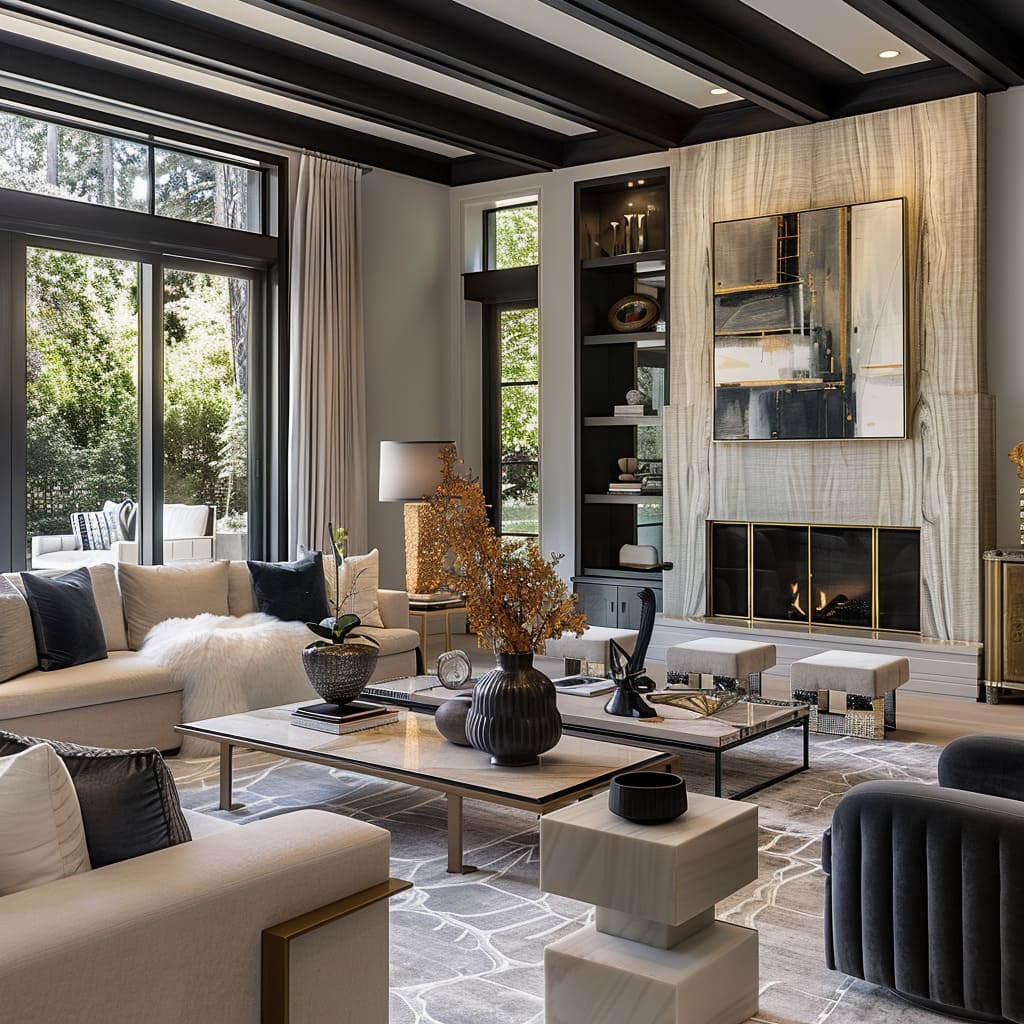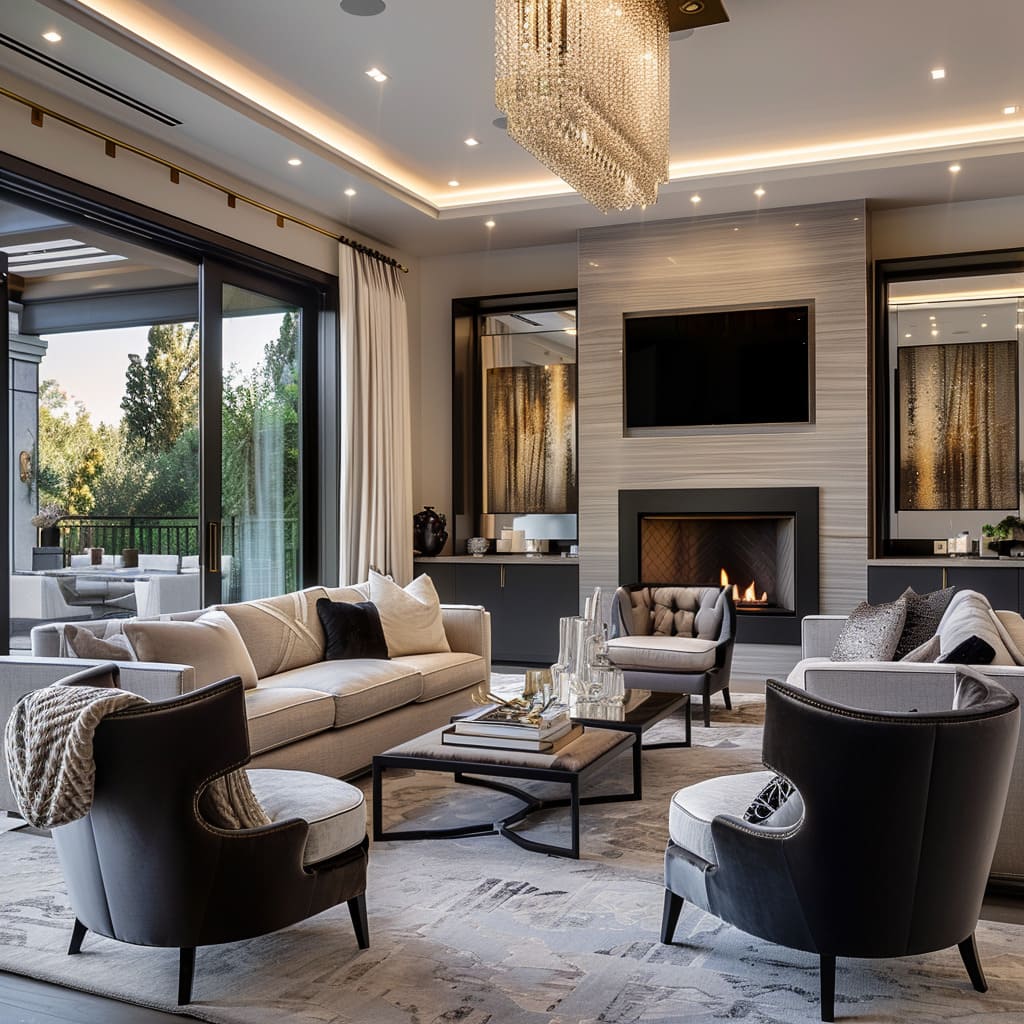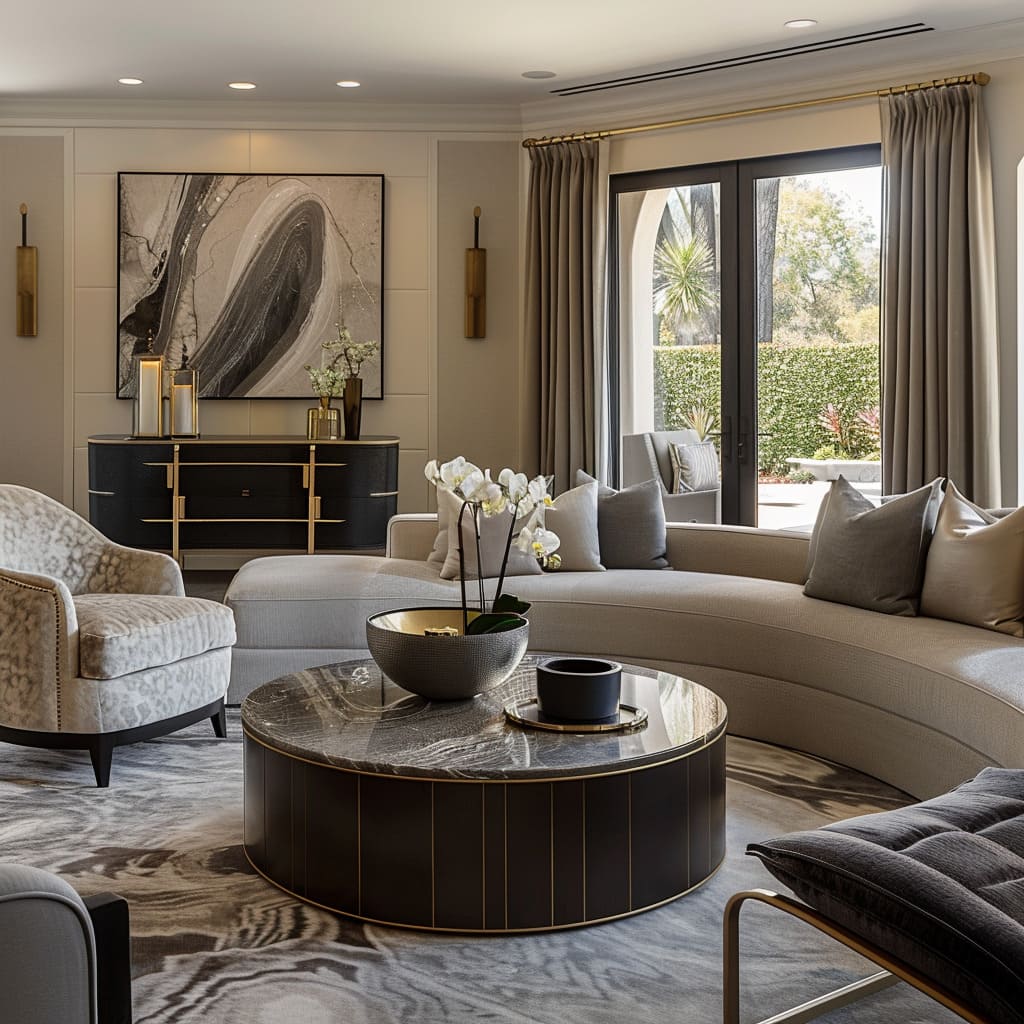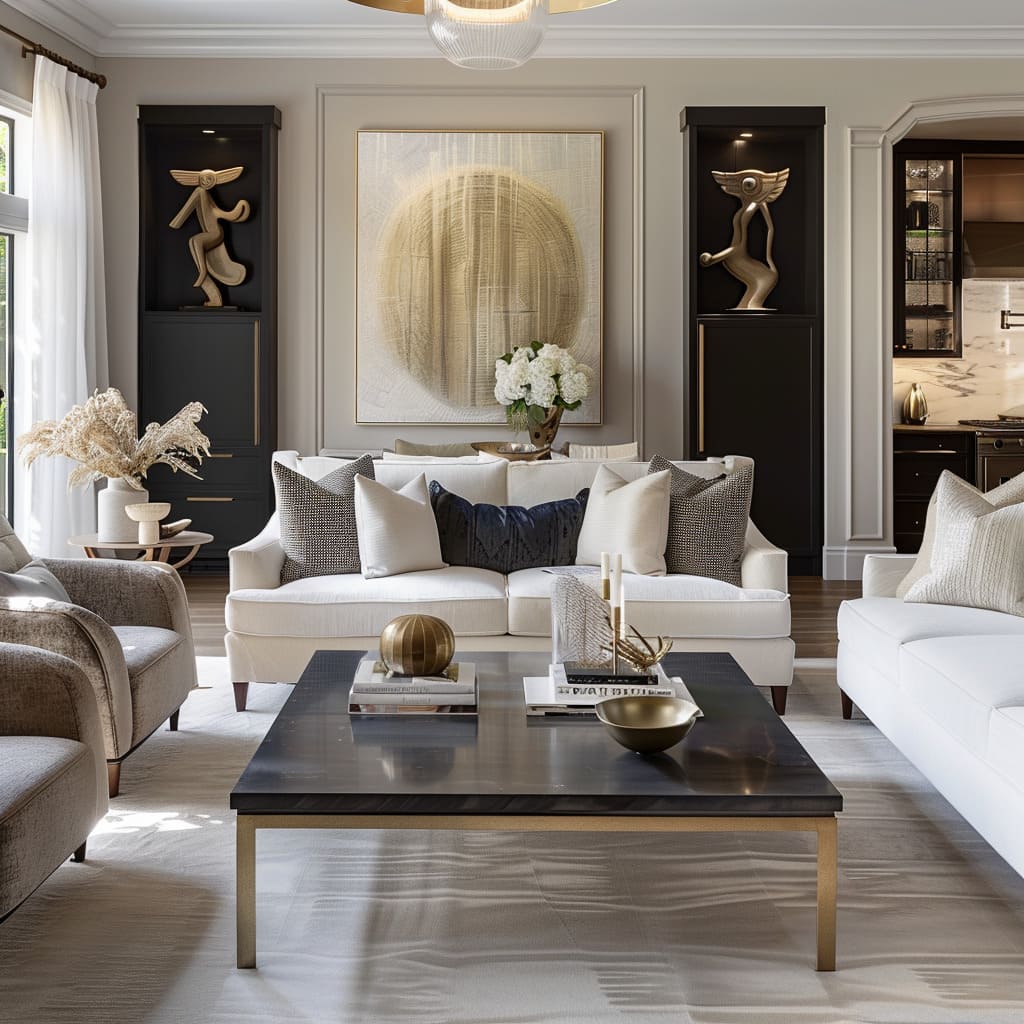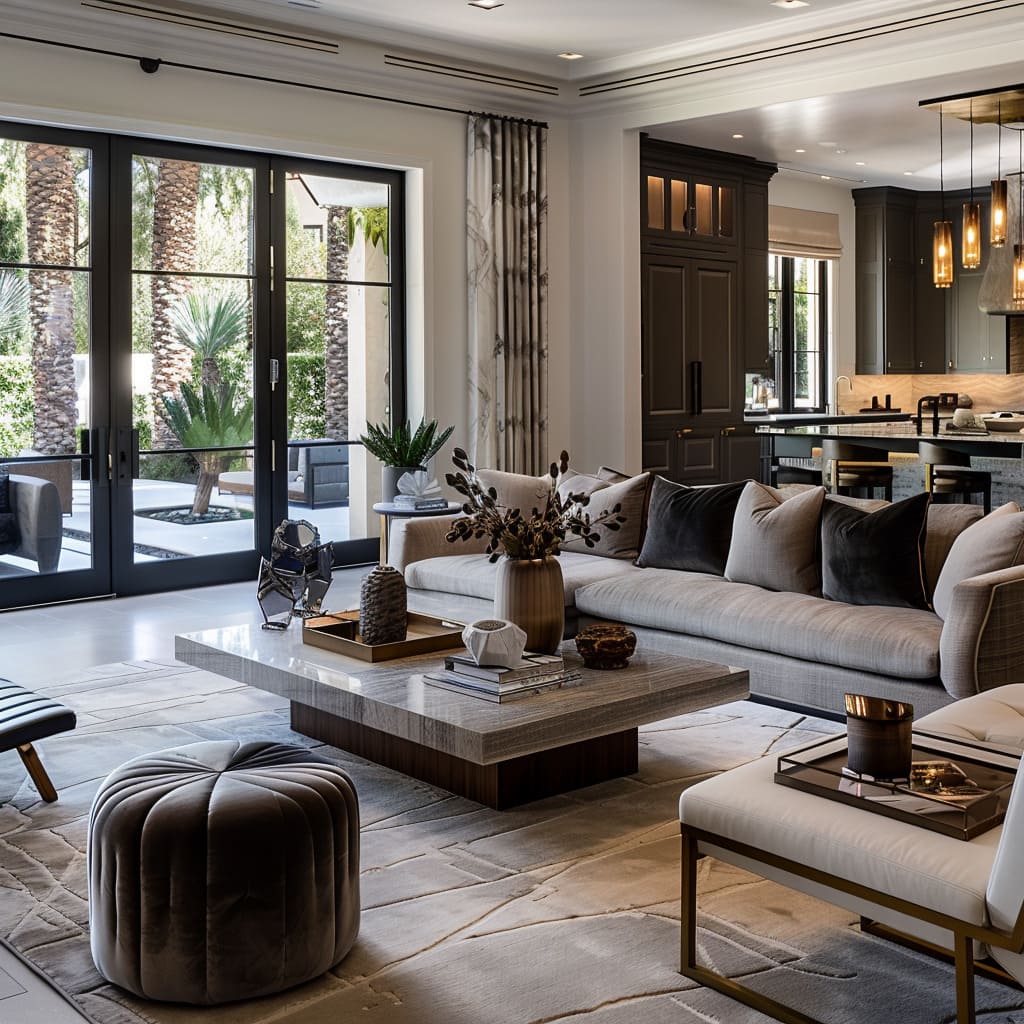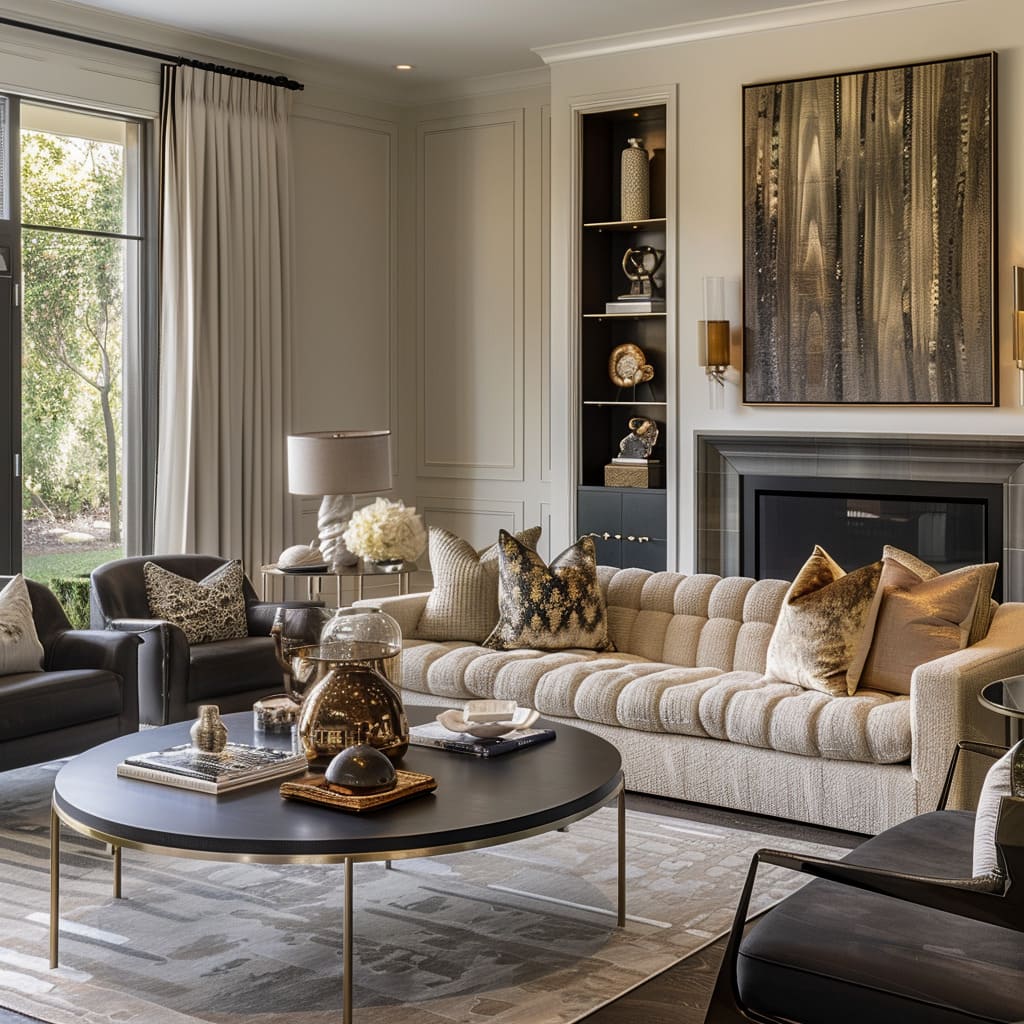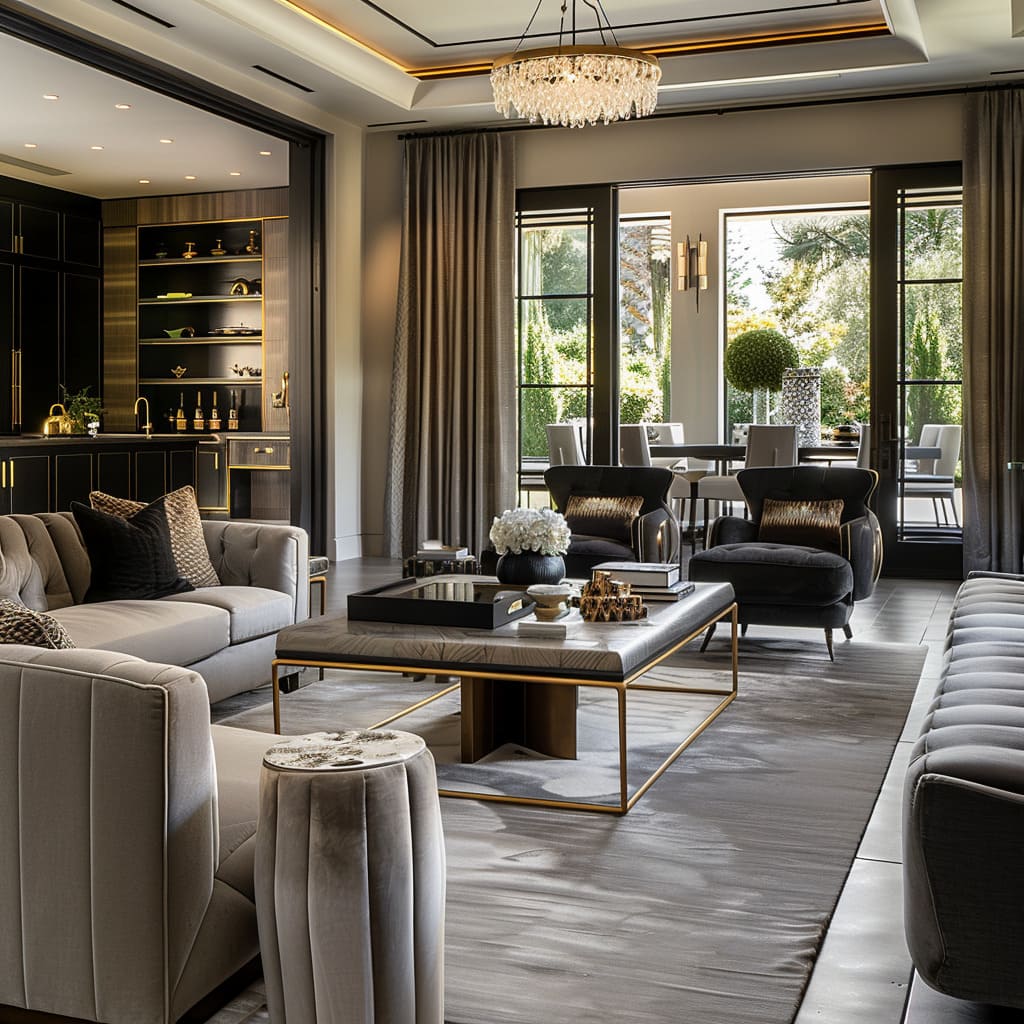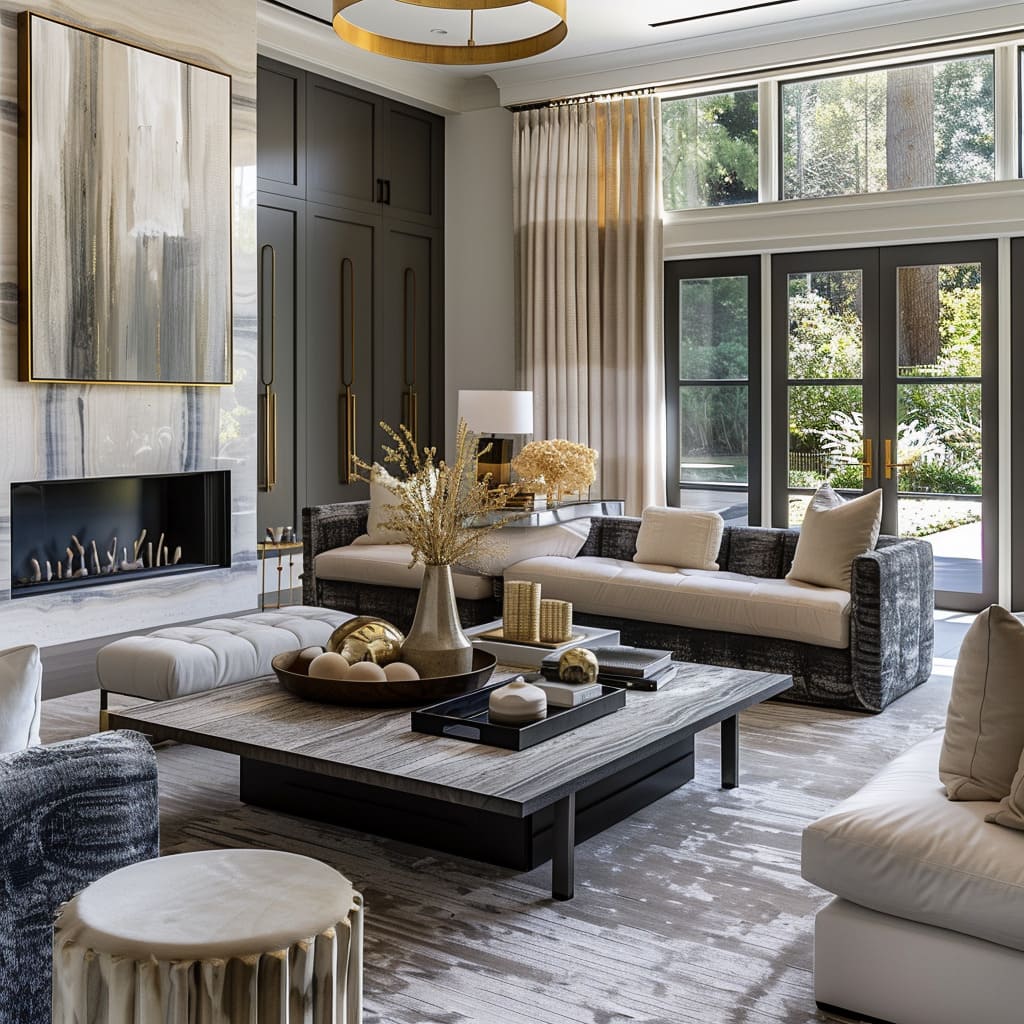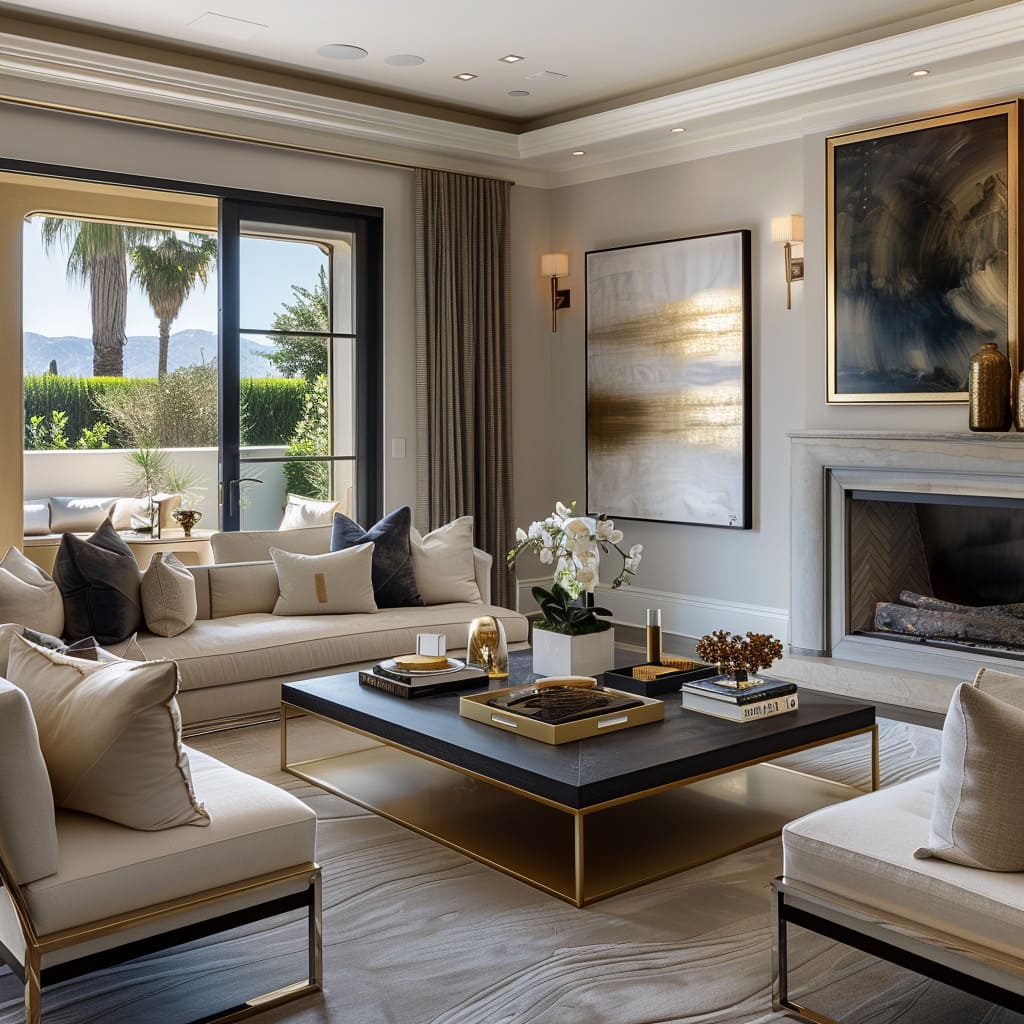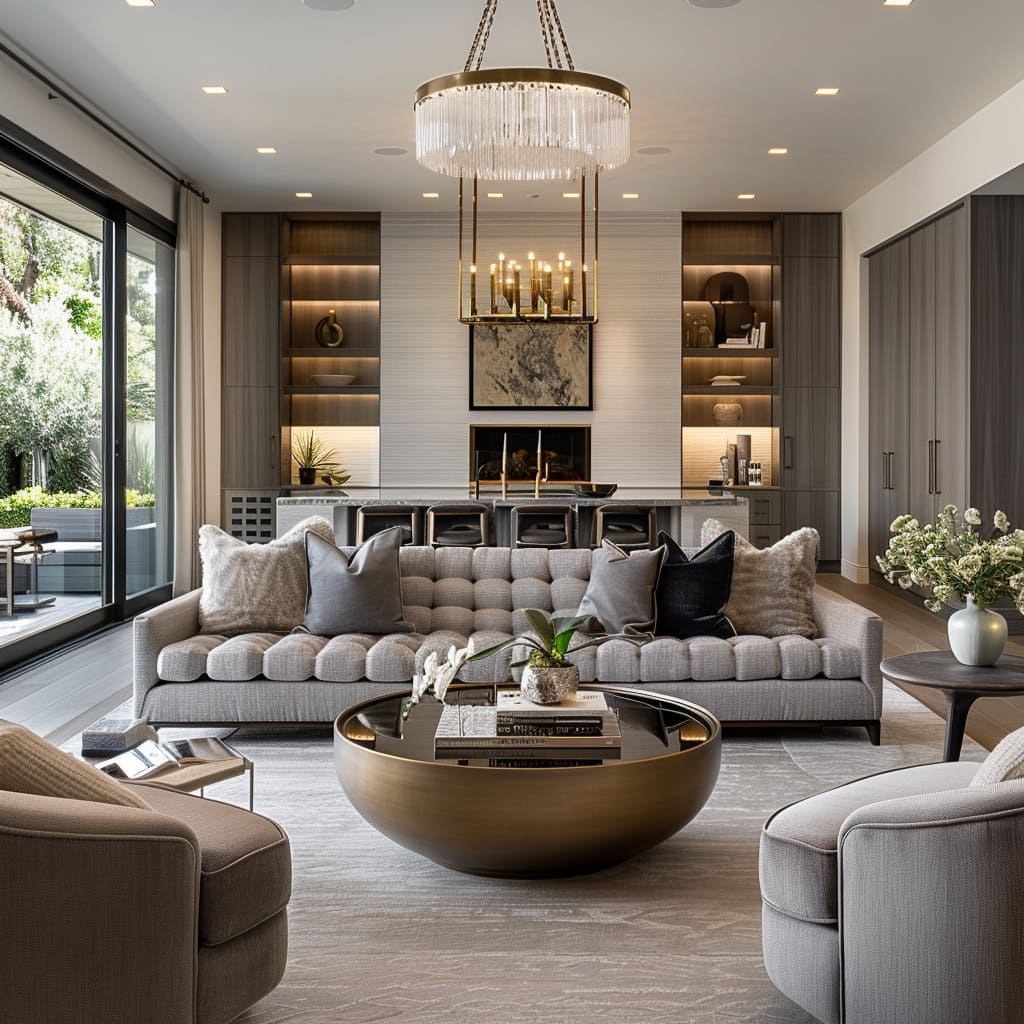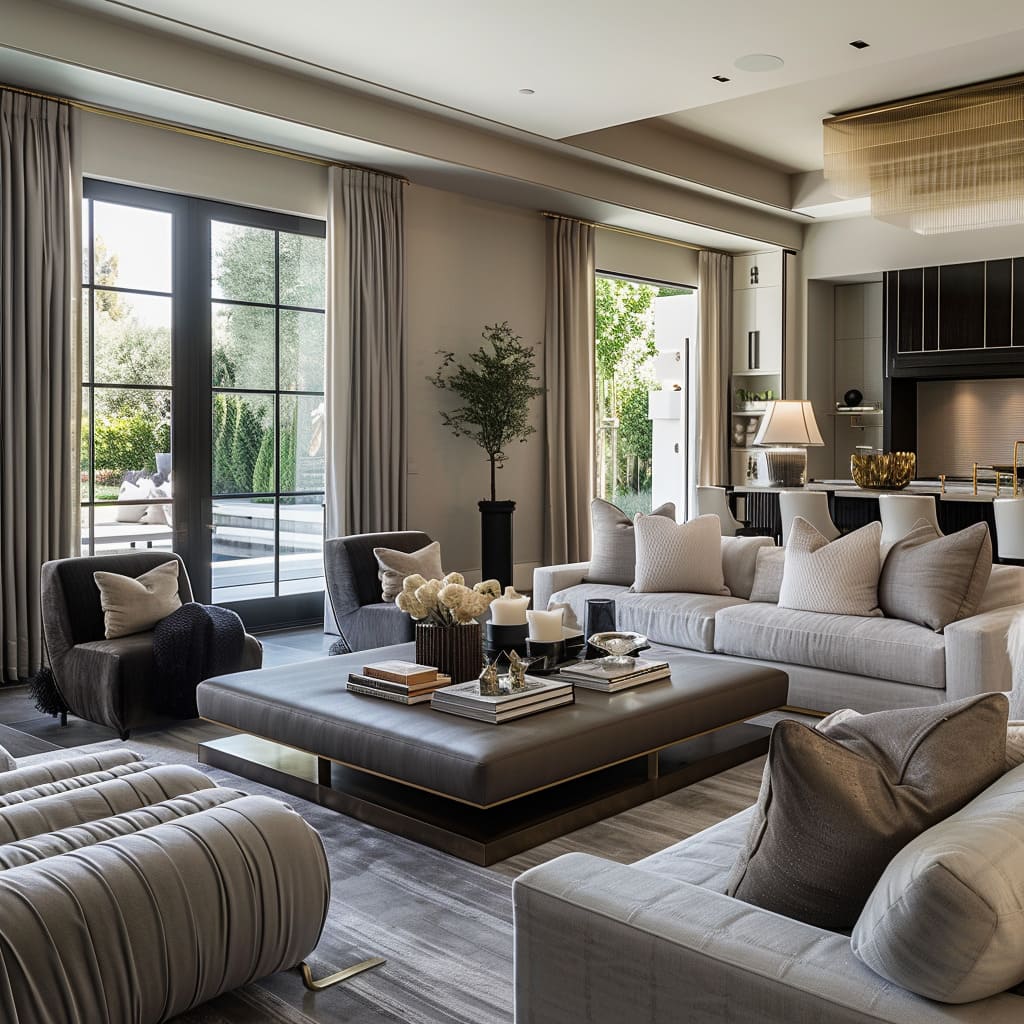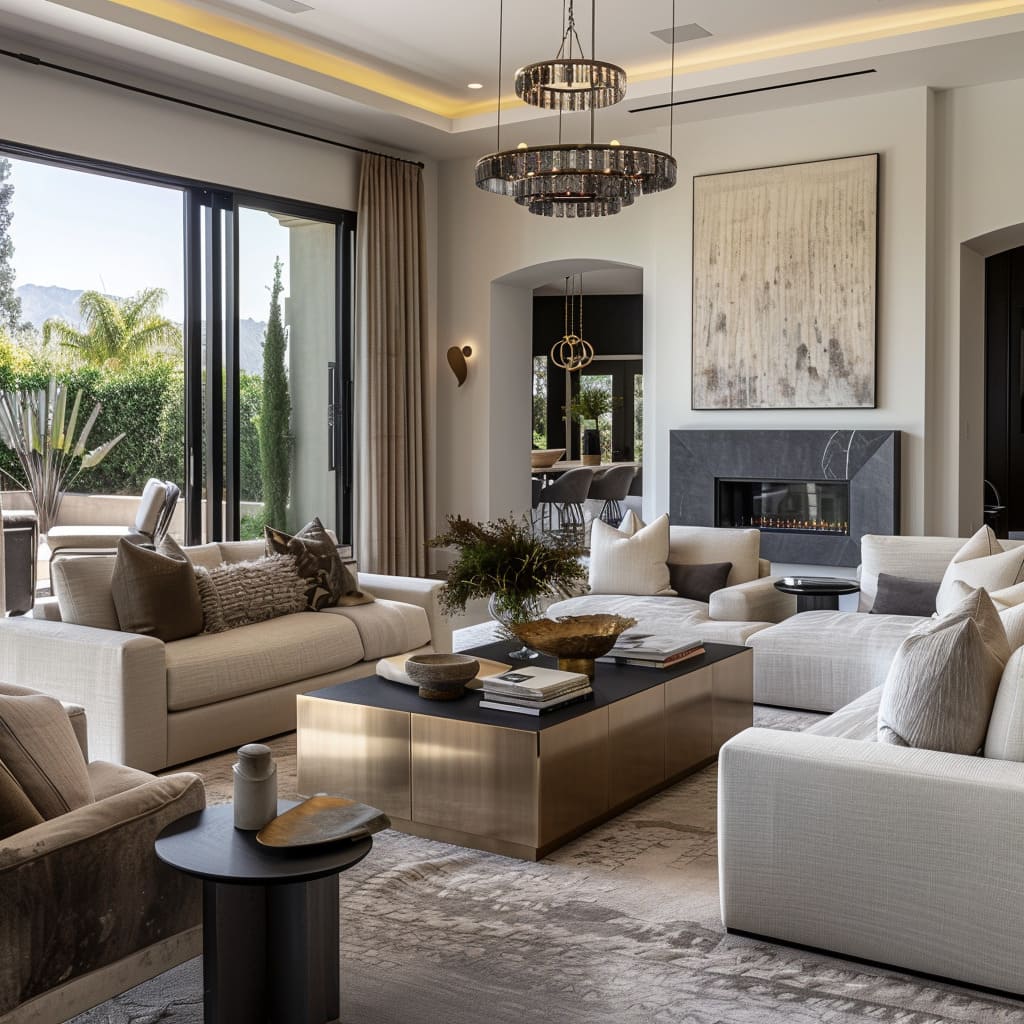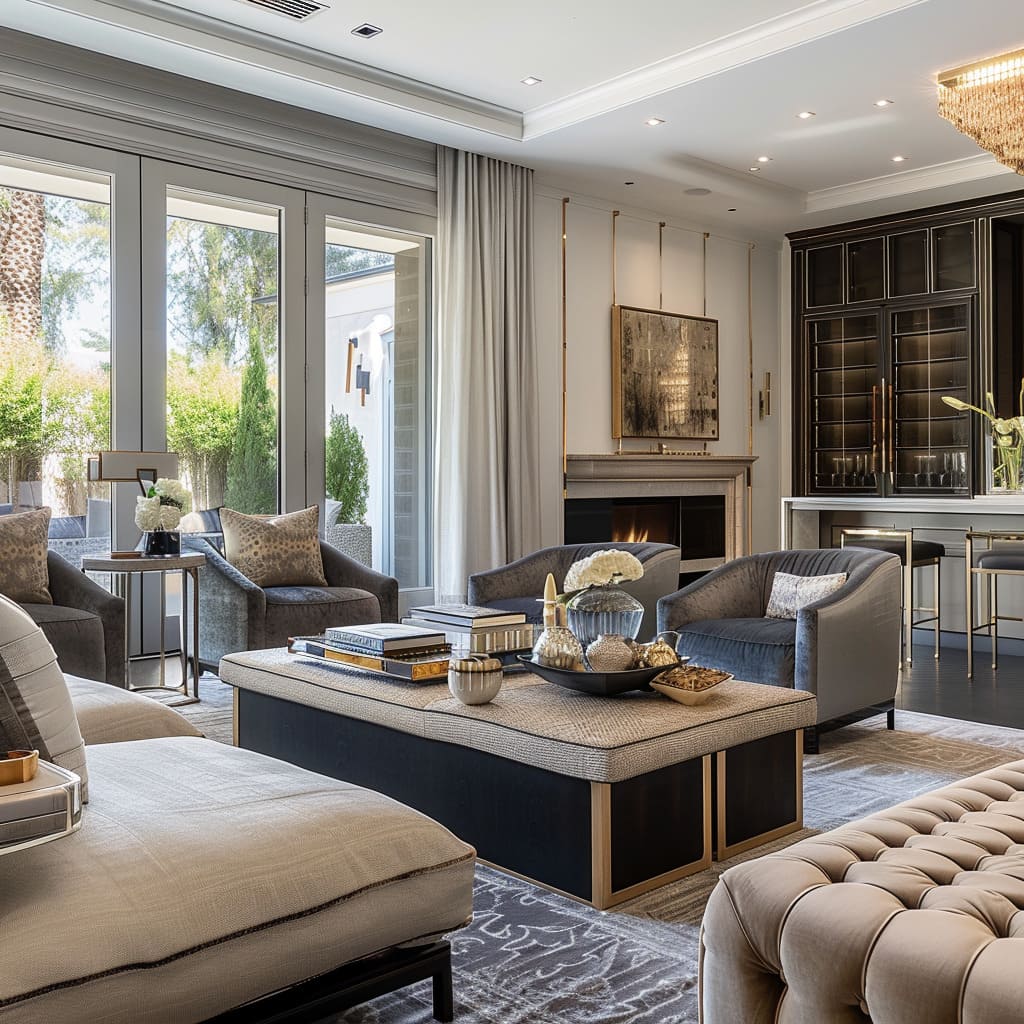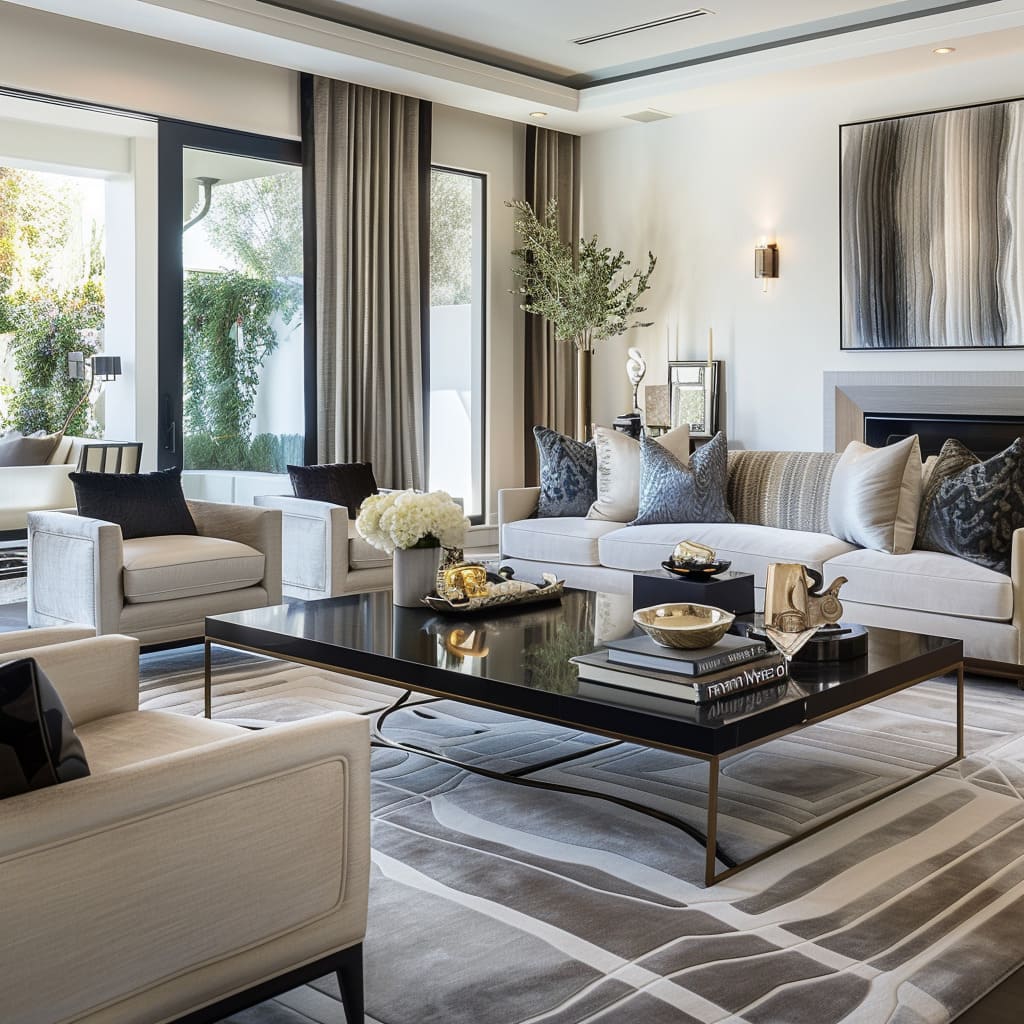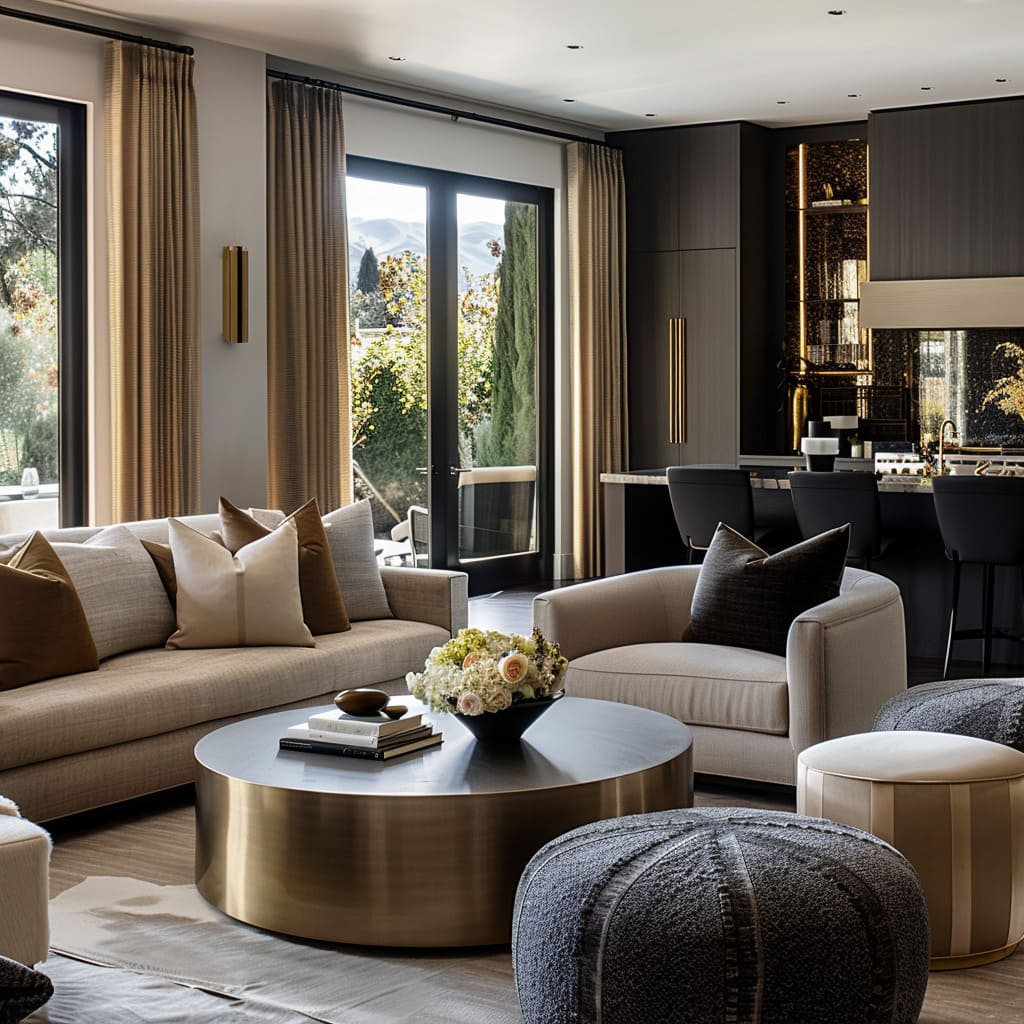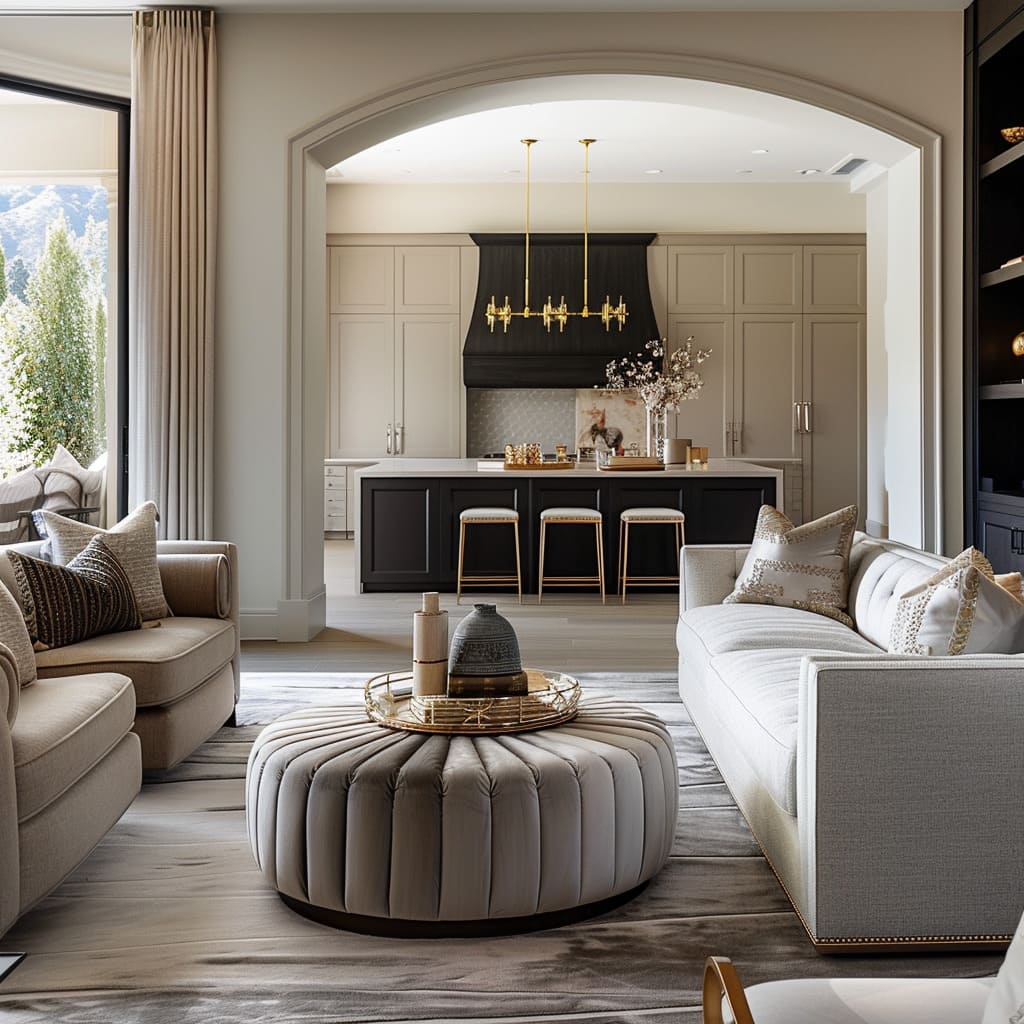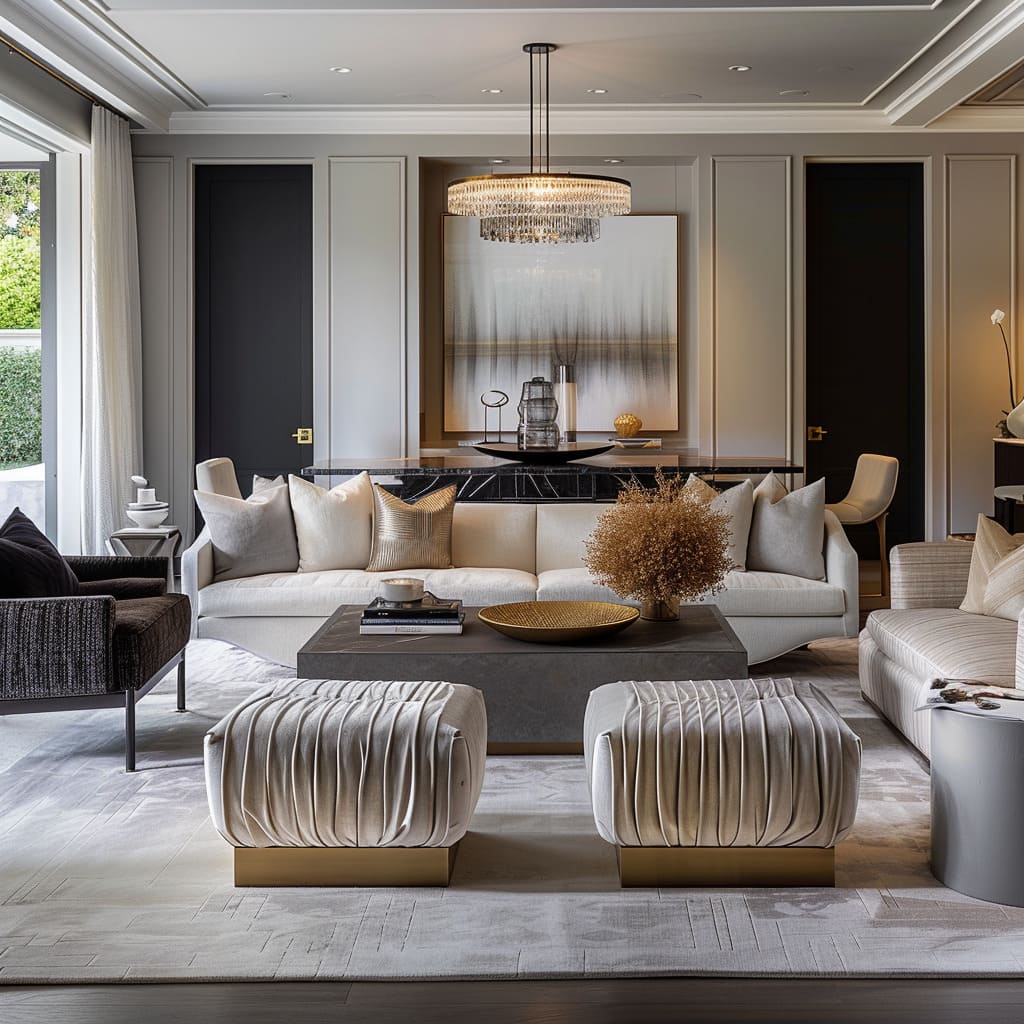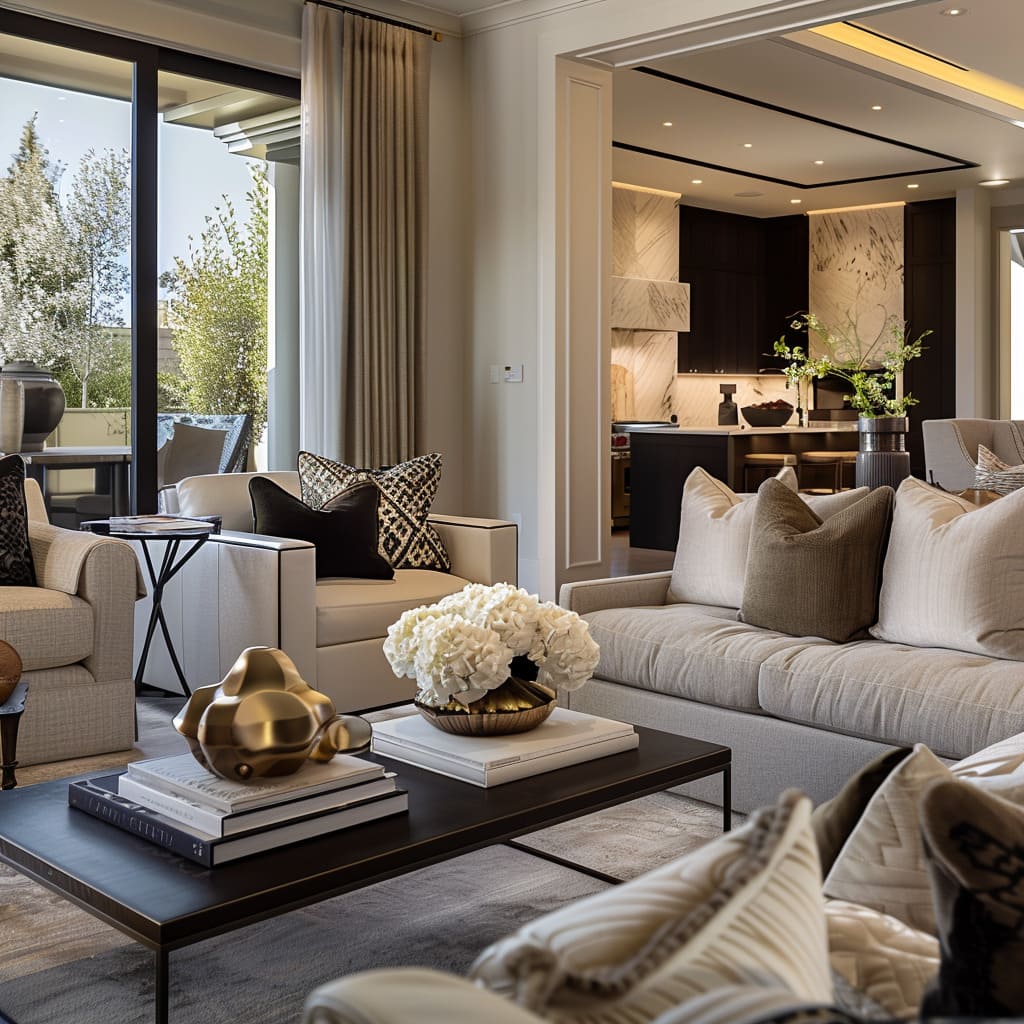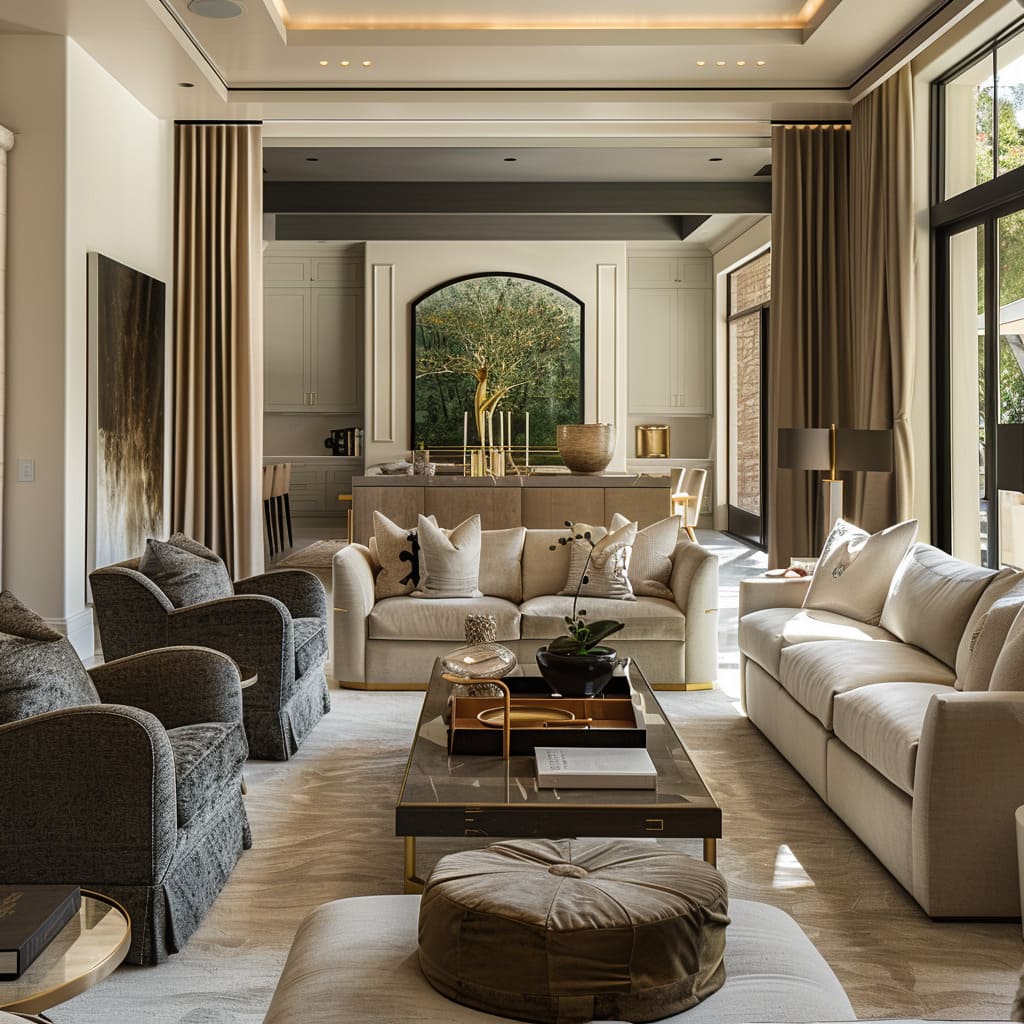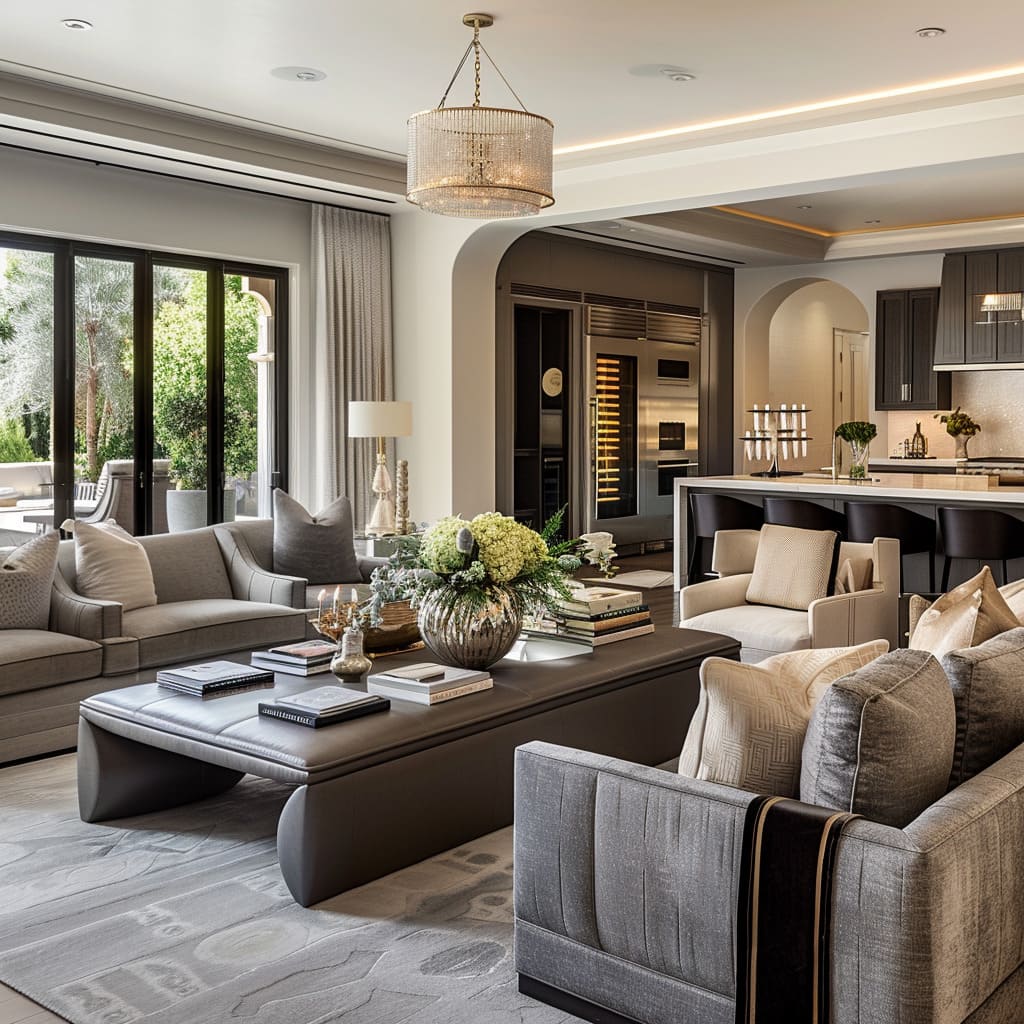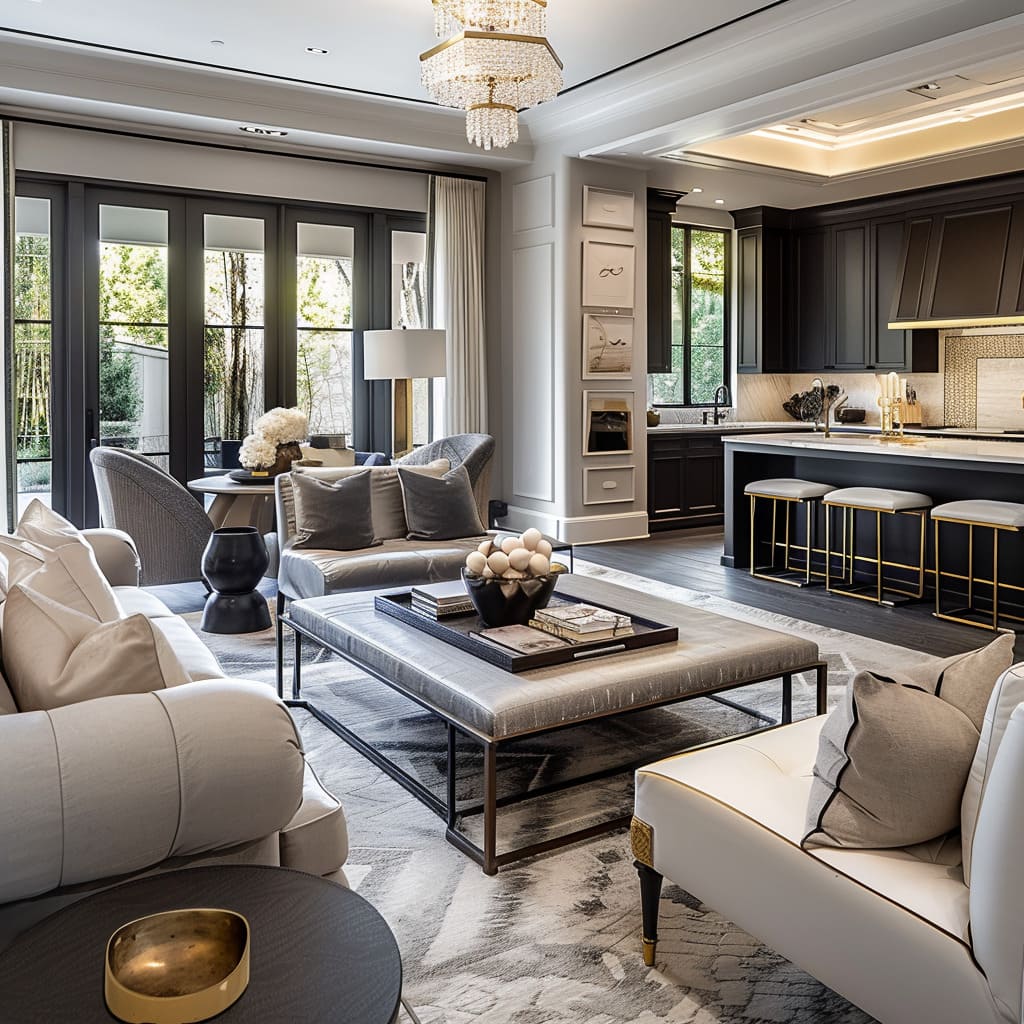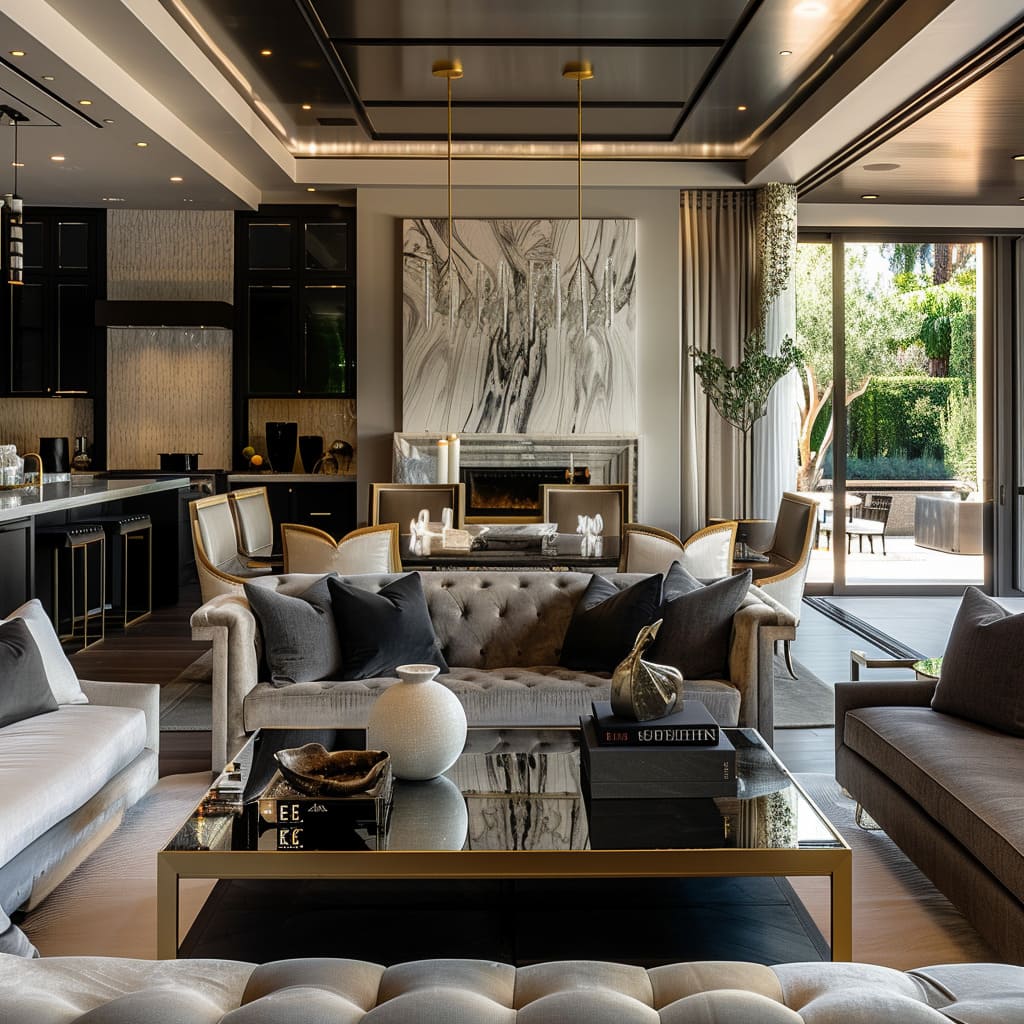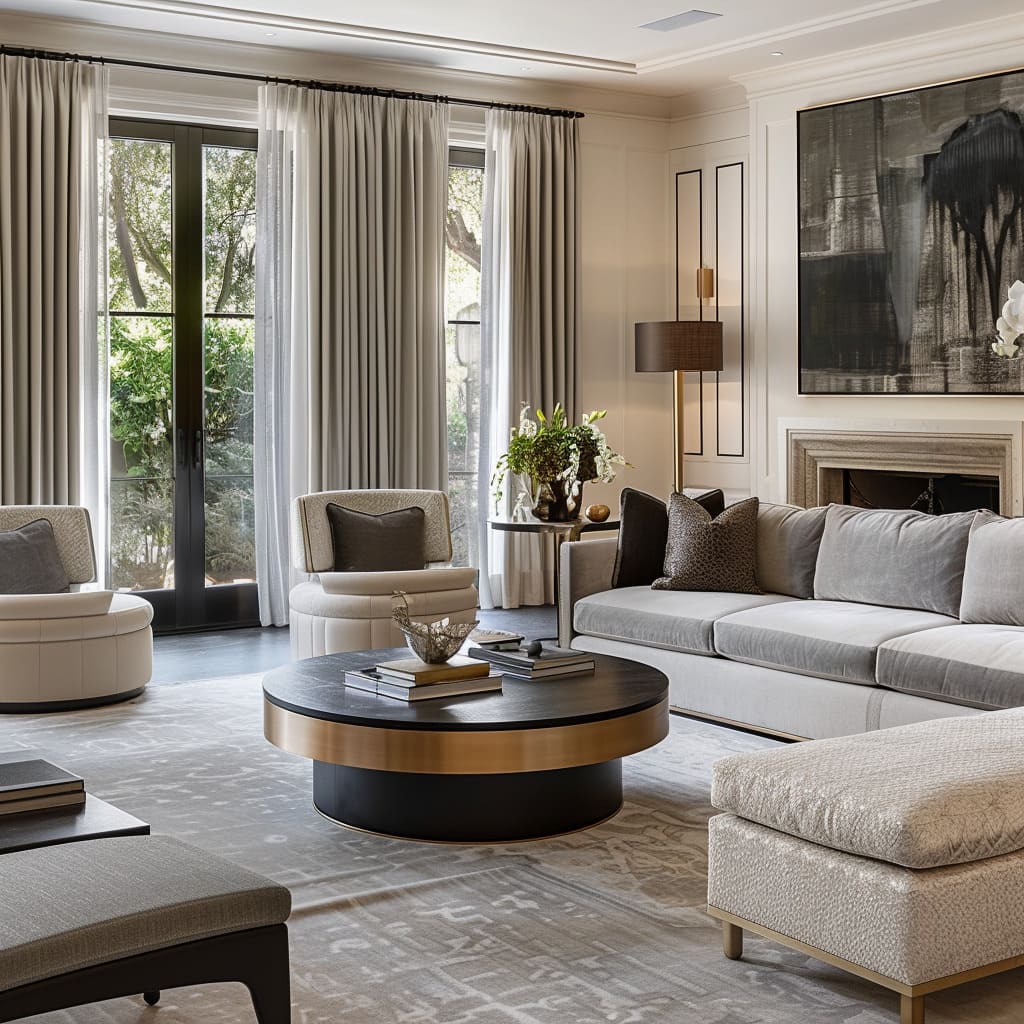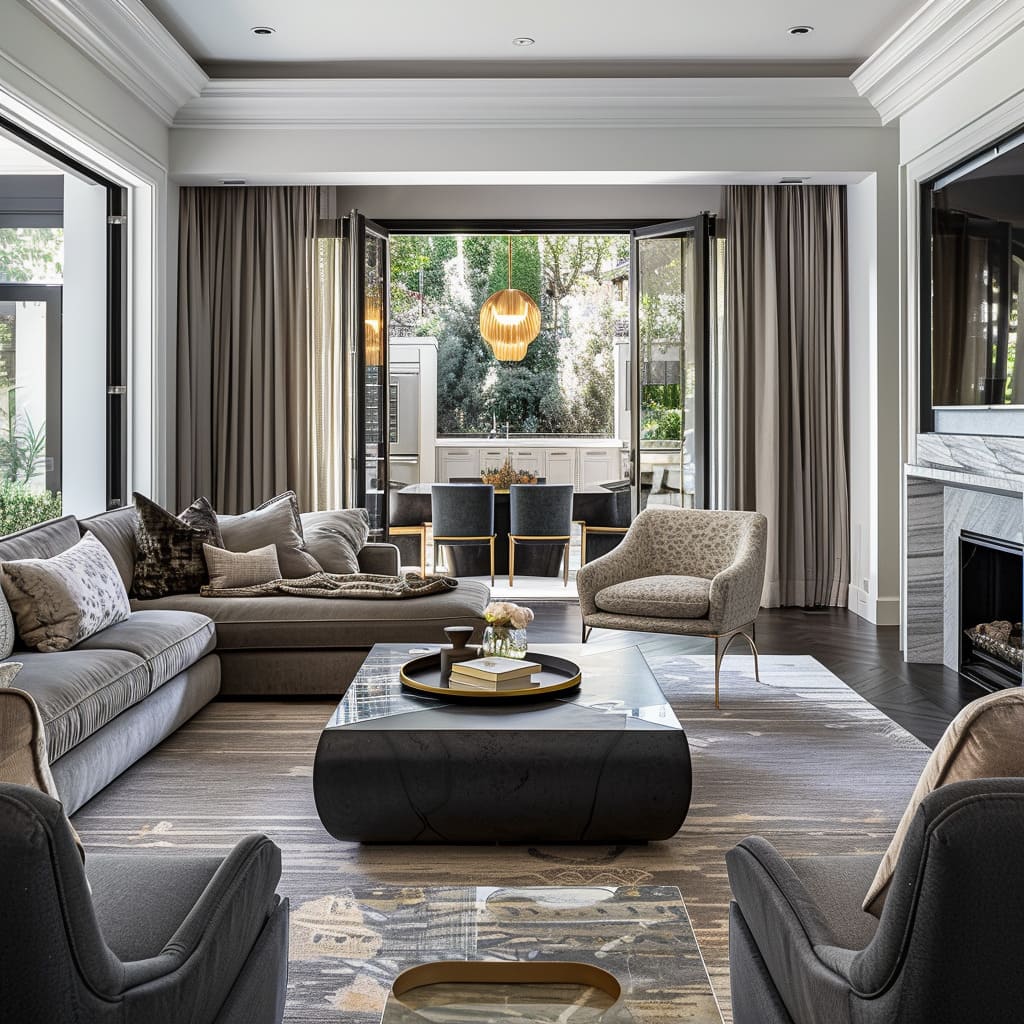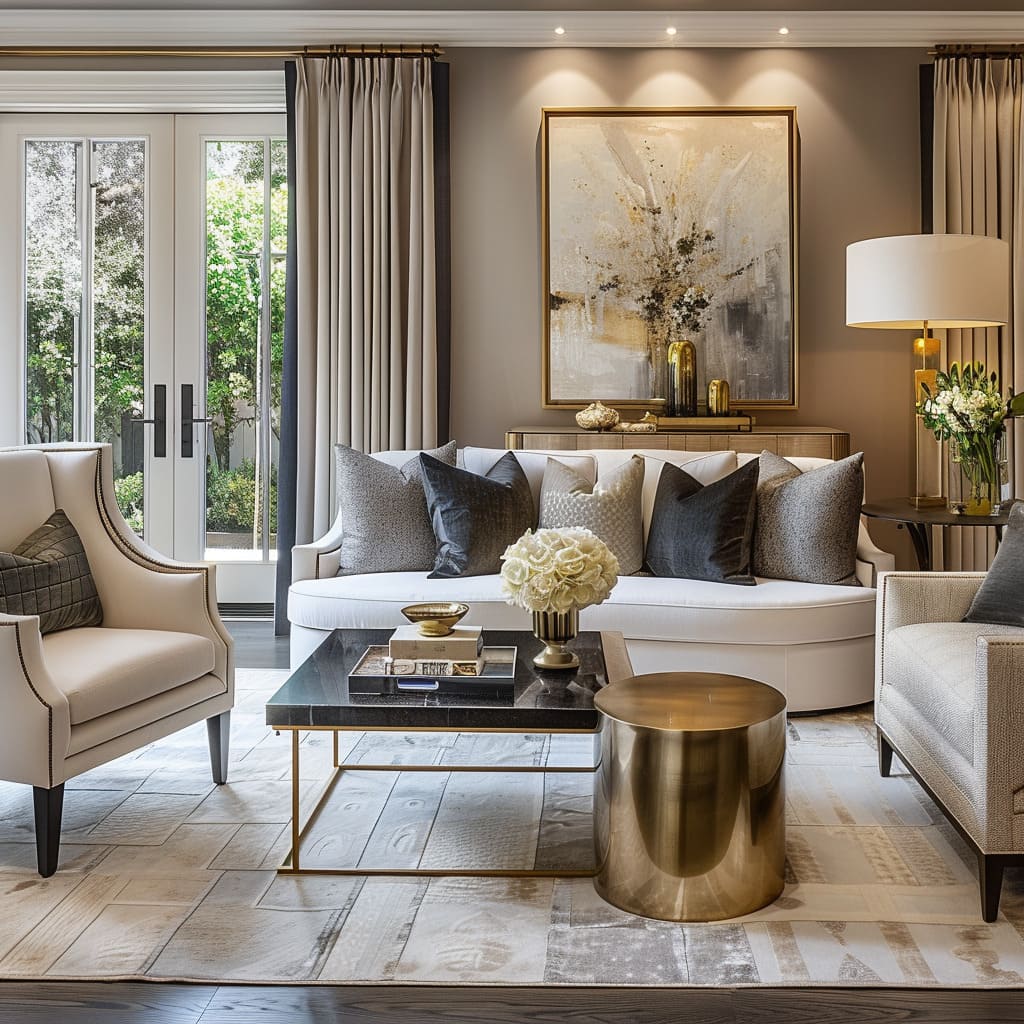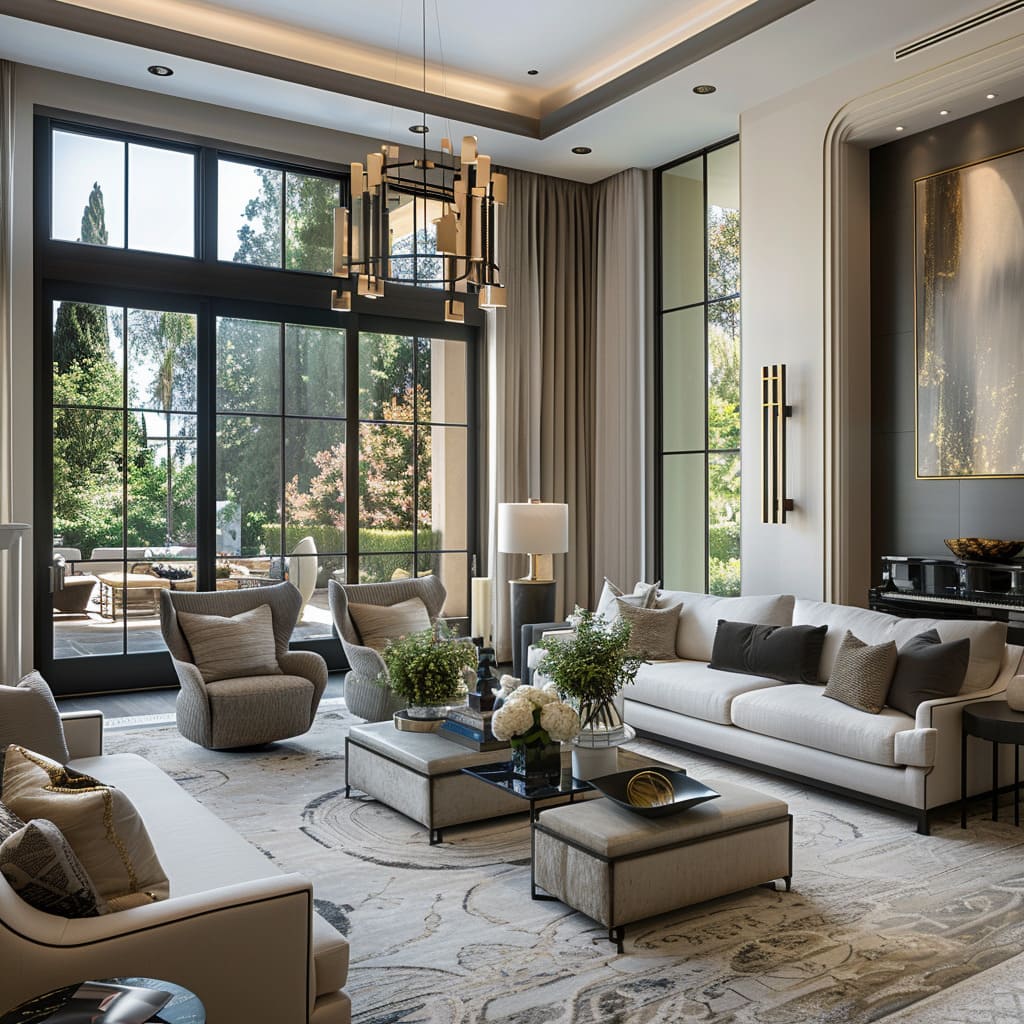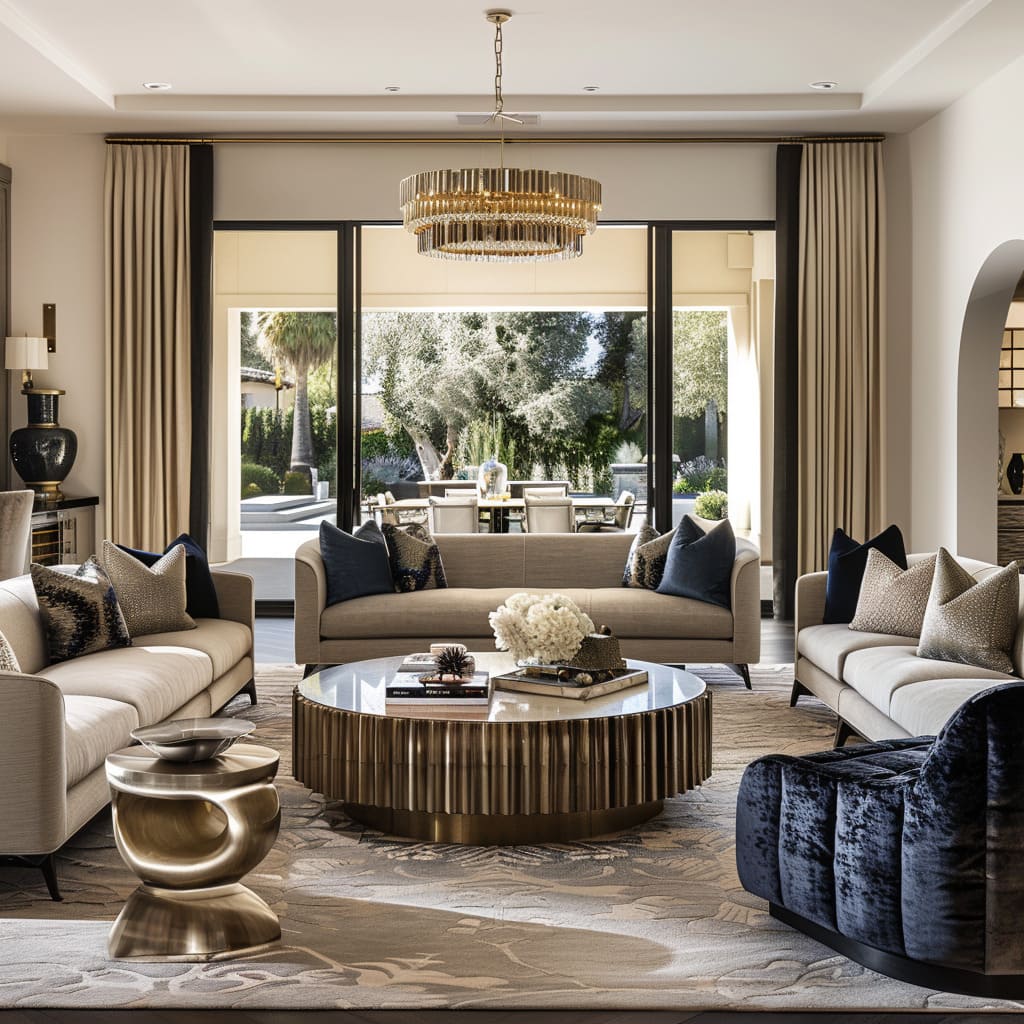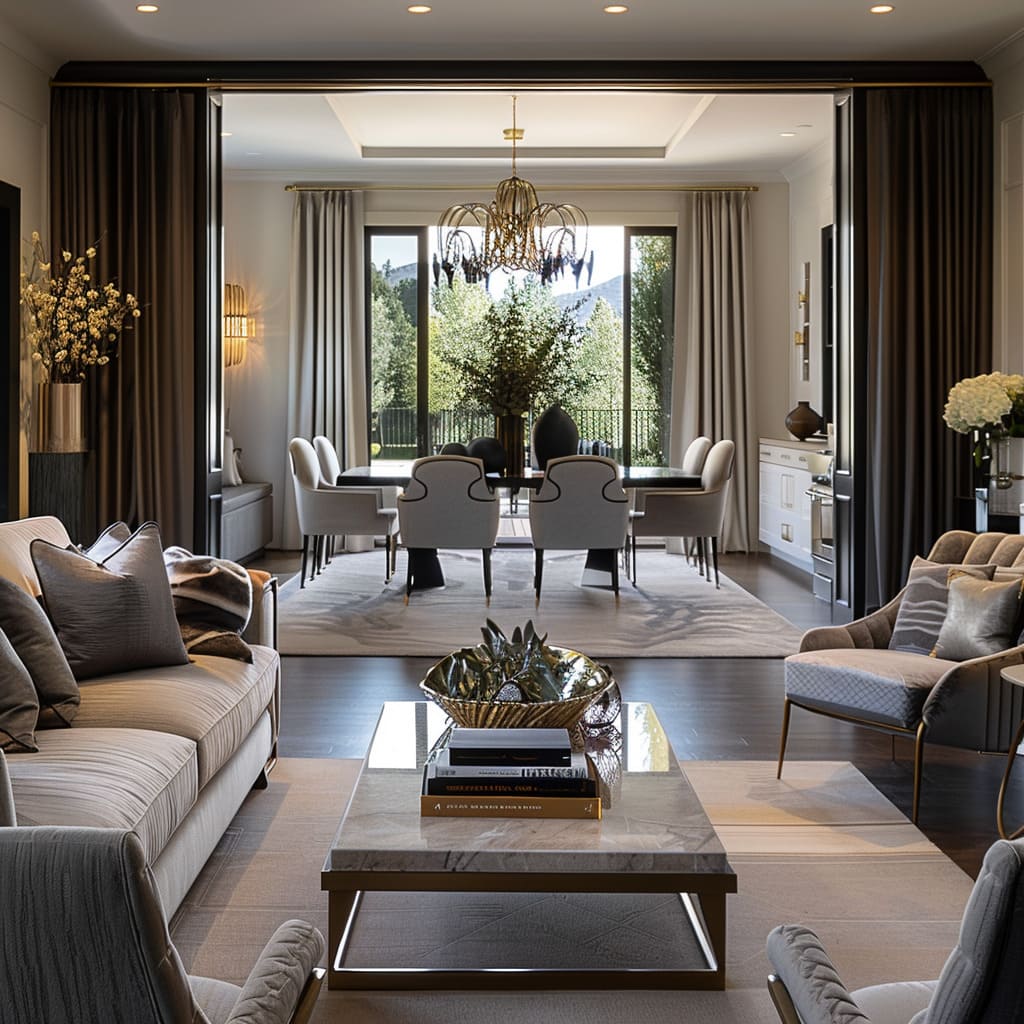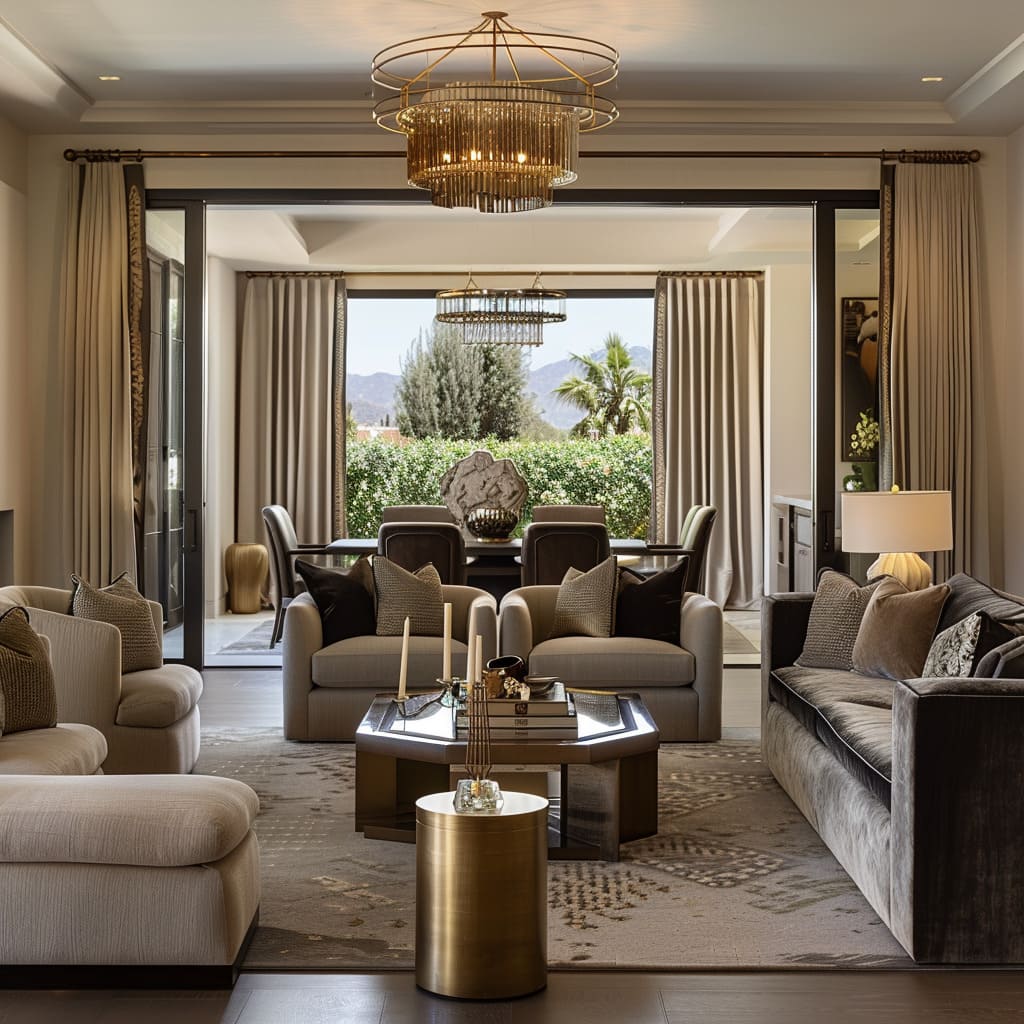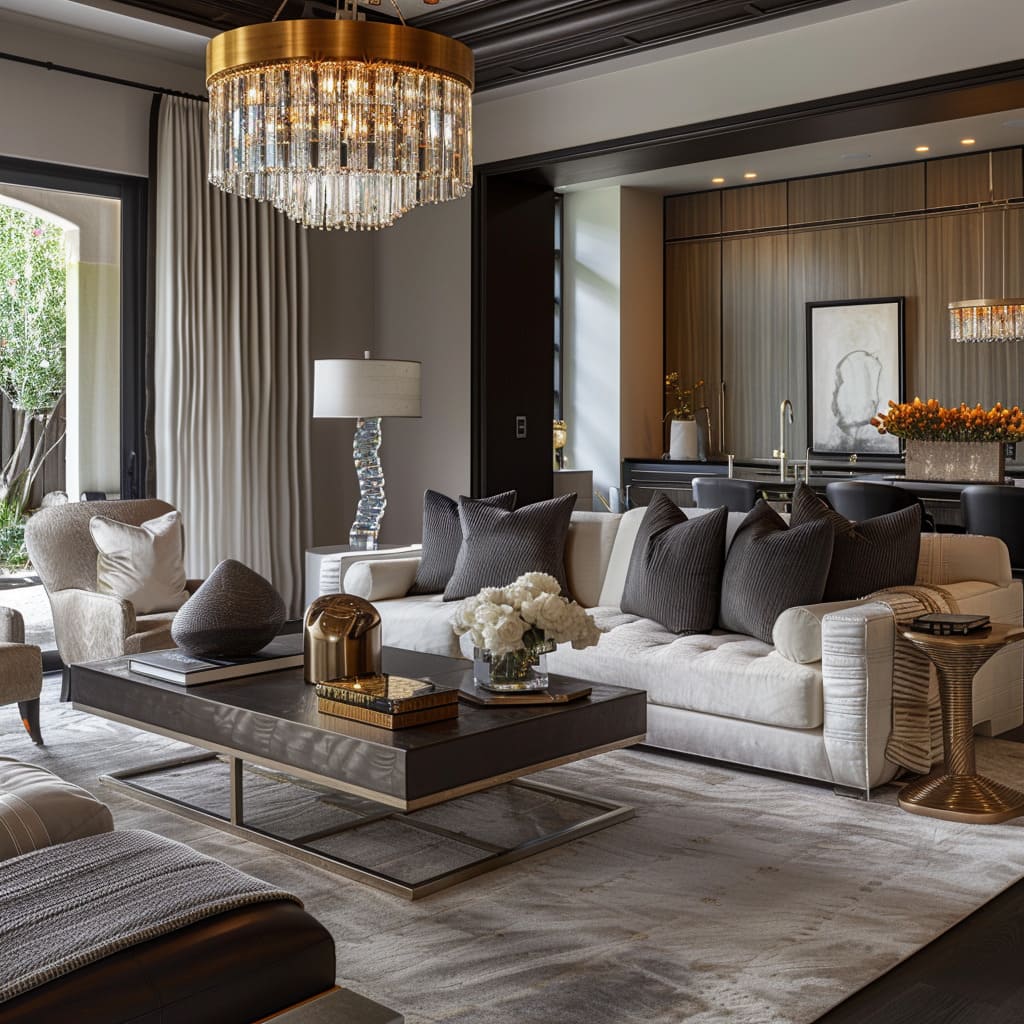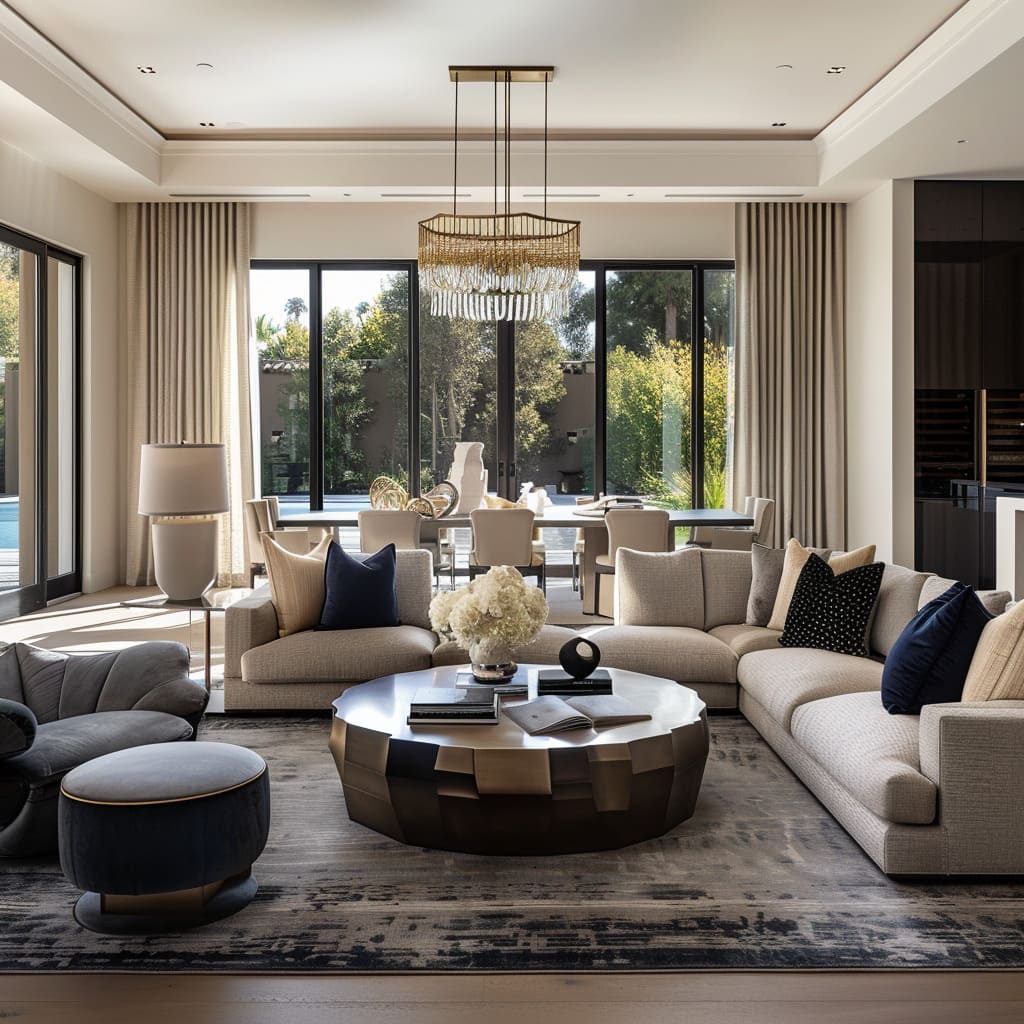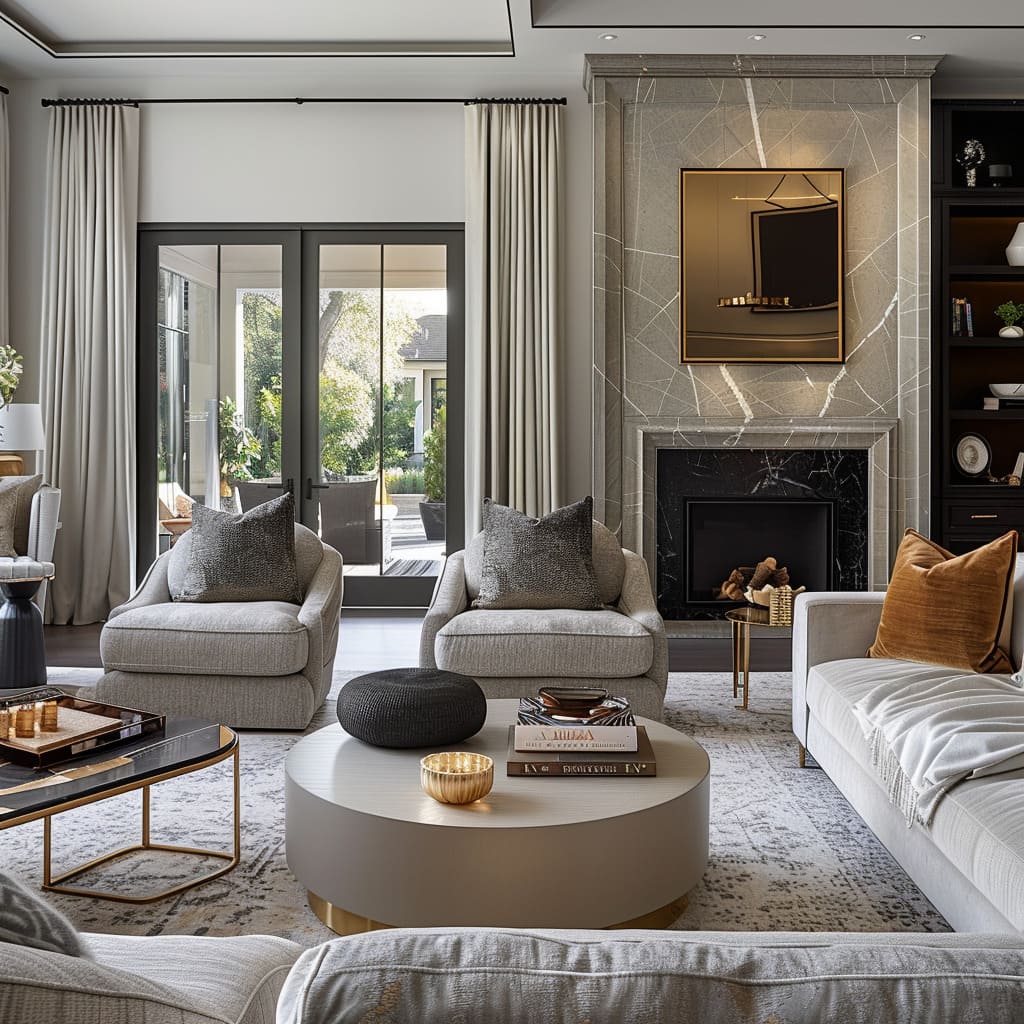The transitional interior design is a study in balance and refinement, an aesthetic that weaves together the warmth of traditional design with the clean lines of modernity. This article delves into the intricacies of luxurious transitional spaces, where every aspect is a thoughtful convergence of form and function.
We explore the nuanced approach to architectural details, the judicious use of textures, the seamless flow between spaces, the meticulous curation of details, and the subtle embrace of innovation.
These are interiors where every element is selected with intention, creating environments that are both timeless and of the moment. From the quiet sophistication of the materials to the discreet integration of modern technology, transitional design stands as a testament to the beauty of balance.
Architectural Enrichment
In transitional interior design, the bones of the space are as crucial as the furnishings that fill it. Architectural enrichment breathes life into the design, with each structural element meticulously chosen to honor both the past and present.
This harmonious blend is seen in the subtle color blocking that deepens spatial perception and the organic forms that introduce softness to structured spaces. Crown moulding and baseboards pay homage to traditional design, while innovative ceiling treatments like coffered and tray ceilings lend a stately air to the rooms.
Understated Color Blocking
This technique brings forth a clever use of muted shades to delineate different areas of a room without the stark contrasts often found in modern design. The soft transitions between hues enhance the architectural lines without creating visual clutter.
Organic Forms
Incorporating gentle curves in archways or furniture profiles offers a refreshing divergence from the rigidness often associated with contemporary design. These forms mimic the fluidity found in nature, providing a serene and calming influence within the living space.
Use of Moulding
By bridging the gap between ceiling and walls with crown moulding, the space is given a refined framework. The moulding often features subtle detailing, which draws upon classical architecture, presenting an understated depth and sophistication to the perimeter of each room.
Ceiling Treatments
These elaborate ceiling designs command attention, drawing the gaze upward to appreciate the dimensionality and intricate craftsmanship. Whether it’s the geometric precision of coffers or the elegant recess of a tray, these treatments transform the ceiling into a canvas of architectural artistry.
Transitional Window Shapes
Windows are not merely openings but are framed to become integral aspects of the design, often featuring mullions that offer a nod to the past while large expanses of glass look out to modern vistas, marrying the exterior and interior in a visual continuum.
Ceiling Features
Beams that traverse the ceiling, whether purely decorative or structural, add a rhythm to the overhead space, while medallions provide a vintage aesthetic that punctuates the ceiling with historical references, often serving as the base for lighting fixtures that are pieces of art in their own right.
Elegance in Utility
The transitional style deftly marries elegance with utility, reflecting a keen understanding of modern living needs. The result is a space that’s as functional as it is beautiful.
Non-traditional fireplaces become functional art, while multifunctional spaces speak to an adaptive lifestyle. Custom joinery ensures that every inch serves a purpose, and the artful zoning through furniture placement creates distinct areas within an open-plan space.
Custom Joinery
The craftsmanship in custom joinery extends beyond mere storage solutions, integrating seamlessly into the overall design. These built-in elements are meticulously designed to utilize every inch of space efficiently, offering a sleek and clutter-free environment.
The joinery often features innovative designs, such as hidden compartments or multifunctional units, which serve aesthetic and practical roles, enhancing the room’s functionality while adding to its visual appeal.
Non-Traditional Fireplaces
Today’s fireplaces transcend their traditional role, becoming centerpieces that captivate and draw the eye. Their modern, linear designs provide a contemporary twist, turning them into functional art pieces that anchor the living space.
These fireplaces often incorporate unconventional materials or unique installation techniques, contributing to the room’s dynamic yet cohesive aesthetic.
Multifunctional Spaces
In transitional design, rooms are crafted to adapt to the evolving needs of modern life. These spaces might combine a home office with a relaxation area or a reading nook within a larger living room, offering versatility and efficiency.
The design ensures that each area is well-defined while maintaining a sense of unity and flow, allowing the inhabitants to utilize the space in various ways as their needs change.
Zoning Through Furniture Placement
Strategic furniture arrangement is key to defining different areas within an open-plan space, creating distinct zones without the need for walls.
This approach to zoning maintains the openness of the layout while providing structure and purpose to each section. The placement of furniture is thoughtfully considered to facilitate conversation, movement, or focus, depending on the intended use of each zone, demonstrating a masterful blend of form and function.
Tactile and Visual Textures
Textures play a pivotal role in transitional interior design, engaging the sense of touch and sight to create a layered and inviting experience. Wall paneling and tactile wall coverings add depth and warmth, while matte and satin finishes offer sophistication without unnecessary gleam.
Patterns are chosen with restraint, ensuring they contribute to the space without dominating it.
Wall Paneling
Beyond mere decoration, wall paneling serves to segment vast walls, lending scale and proportion to rooms. These panels can introduce a geometric pattern to a space, with the interplay of shadow and light creating a dynamic visual effect.
The use of recessed and raised panels can suggest an added level of detail and craftsmanship.
Matte and Satin Finishes
These understated finishes play with light in a subdued manner, promoting a sense of calm and elegance.
Selective Use of Patterns
Patterns, when used, are carefully integrated to ensure they contribute to the room’s harmony. Tone-on-tone patterning offers a subtle visual interest that complements rather than competes with the broader design scheme.
This controlled use of pattern can be particularly effective in soft furnishings, such as throw pillows or rugs, where it adds complexity and richness.
Tactile Wall Coverings
The wall coverings in a transitional space beg to be touched. Materials such as silk, linen, and grasscloth offer an organic texture that is visually inviting and pleasant to the touch.
These coverings can be employed not only for their beauty but also for their acoustic properties, softening sound and contributing to the room’s overall sense of quiet luxury.
Seamless Integration and Flow
A hallmark of transitional design is the seamless flow between spaces, facilitated by a careful selection of design elements that bridge different areas. Variation in ceiling height delineates spaces subtly, while calm visual transitions maintain an uninterrupted aesthetic journey throughout the home.
This continuity is echoed in the consistent use of hardware finishes and the visual continuity in flooring.
Variation in Ceiling Height
The strategic alteration of ceiling heights serves not only to define spaces but also to evoke different atmospheres within each area.
Higher ceilings in living spaces can impart a sense of grandeur and openness, while lower heights in more intimate settings create coziness and warmth. This ebb and flow of spatial volume plays with perception, lending each space its unique character within the cohesive whole.
Calm Visual Transitions
The eye moves effortlessly from room to room, guided by understated shifts in color and texture. These transitions are akin to a soft whisper, gently indicating a change without disrupting the overall serenity of the space.
In areas where rooms flow into one another, the careful blending of design elements ensures that each space feels like a natural continuation of the last.
Unified Hardware Finishes
Consistent finishes on door handles, light fixtures, and plumbing fixtures act as a subtle unifying thread, tying together the diverse elements of the home. This coherence in hardware creates a sense of order and meticulousness, suggesting that every detail was chosen with intention and care.
Visual Continuity in Flooring
Flooring acts as the stage upon which the drama of home life unfolds, and in transitional design, it does so with quiet grace.
The Art of Detailing
Attention to detail is paramount in transitional design, where even the smallest elements are considered for their aesthetic and functional contributions. From the intricate door hardware to the artful curation of accessories, every detail is thoughtfully integrated to create a cohesive and refined environment.
Custom art installations and pendant and chandelier groupings serve not just as illumination but as art that captivates and delights.
Curation of Accessories
Accessories are not mere fillers in a transitional space; they are handpicked treasures that resonate with the home’s narrative.
Each vase, sculpture, and decorative object is placed with precision, ensuring that it contributes to the aesthetic dialogue without overwhelming the senses. The result is a space that feels both collected and curated, with each accessory adding to the depth and richness of the interior story.
Custom Art Installations
Art in a transitional home is far from generic; it is thoughtfully commissioned or selected to reflect the passions and tastes of the inhabitants. Each piece is more than decor—it’s a conversation starter, a memory keeper, a personal statement.
Positioned with intent, these installations can serve as the centerpiece of a room or as a subtle complement to the overall design theme.
Elegant Drapery
Window dressings are chosen for their ability to complement both the interior and the view beyond. Luxurious fabrics fall from ceiling to floor in a sweep of elegance, framing the windows and softening the natural light.
The drapery’s texture, color, and pattern are in dialogue with the room, enhancing the space without overpowering it.
Pendant and Chandelier Groupings
Lighting is orchestrated to serve as a visual symphony of light and form. Groupings of pendants or chandeliers are composed with the same care as a centerpiece, each fixture selected for its shape, scale, and luminosity.
These clusters not only illuminate but also serve as a sculptural installation that enriches the ceiling plane.
Intricate Door Hardware
The tactile experience of opening a door is elevated through hardware that is as pleasing to the touch as it is to the eye.
Understated Innovation
Contemporary luxury is characterized by an understated approach to innovation and luxury. In transitional interiors, this is expressed through subtle brand integration of high-end appliances and the discreet luxury that emanates from quality and craftsmanship.
The innovative material combinations present a visual and tactile feast, while ensuring that the space remains timeless and understated.
Subtle Brand Integration
In transitional interiors, the prestige of high-end brands is expressed through the seamless integration of their products. Appliances and technological devices are built into the very architecture of the space, flush with surfaces and matching the surrounding materials.
This approach maintains the integrity of the design while providing all the functional benefits of modern innovation.
Innovative Material Combinations
The transitional style’s ingenuity shines through in the unexpected yet harmonious blending of materials. Glass may be set into carved wood frames, or polished metal may accent rough-hewn stone.
These pairings feel both timeless and modern, lending an air of bespoke craftsmanship to the space. The contrast in textures and finishes adds depth and intrigue without sacrificing the design’s coherent aesthetic.
Discrete Luxury
The luxury of a transitional space is not shouted but whispered. It’s found in the hand-stitched seams of custom upholstery, the hand-finished cabinetry, and the precision of well-crafted joints.
This approach to luxury emphasizes a deep appreciation for the skills of artisans and the understated elegance that results from their expertise. The overall effect is one of an environment shaped by discerning tastes and a preference for enduring style over temporary trends.
In conclusion, transitional interior design encapsulates a harmonious blend of aesthetic sensibilities, merging the classic with the contemporary to create spaces that are as comfortable as they are captivating. Throughout this article, we’ve examined the defining characteristics of this design philosophy, highlighting the ways in which it achieves a sense of seamless integration while still celebrating individual elements.
From architectural embellishments that lend character to a room to the infusion of tactile and visual textures that enrich the user experience, transitional design encapsulates a discreet luxury that is felt in every finely crafted detail. It is a design ethos that respects the bones of a space, cherishes innovation, and upholds a level of craftsmanship and quality that transcends the ephemeral trends of the day.



